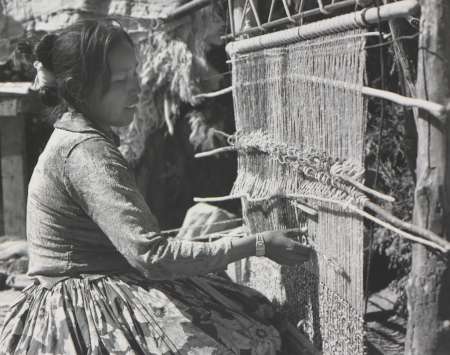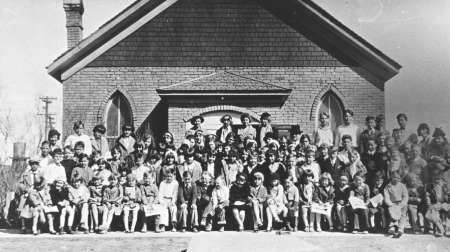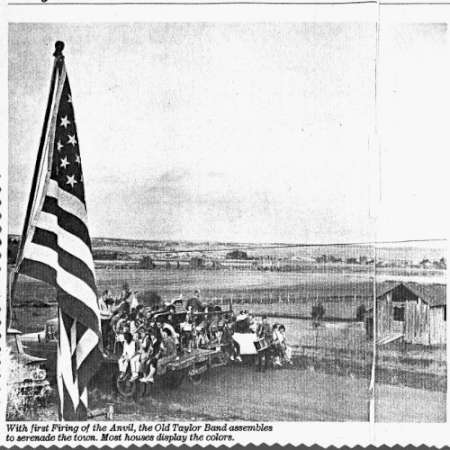- Pinetop-Lakeside
- Show Low
- Farming and Ranching
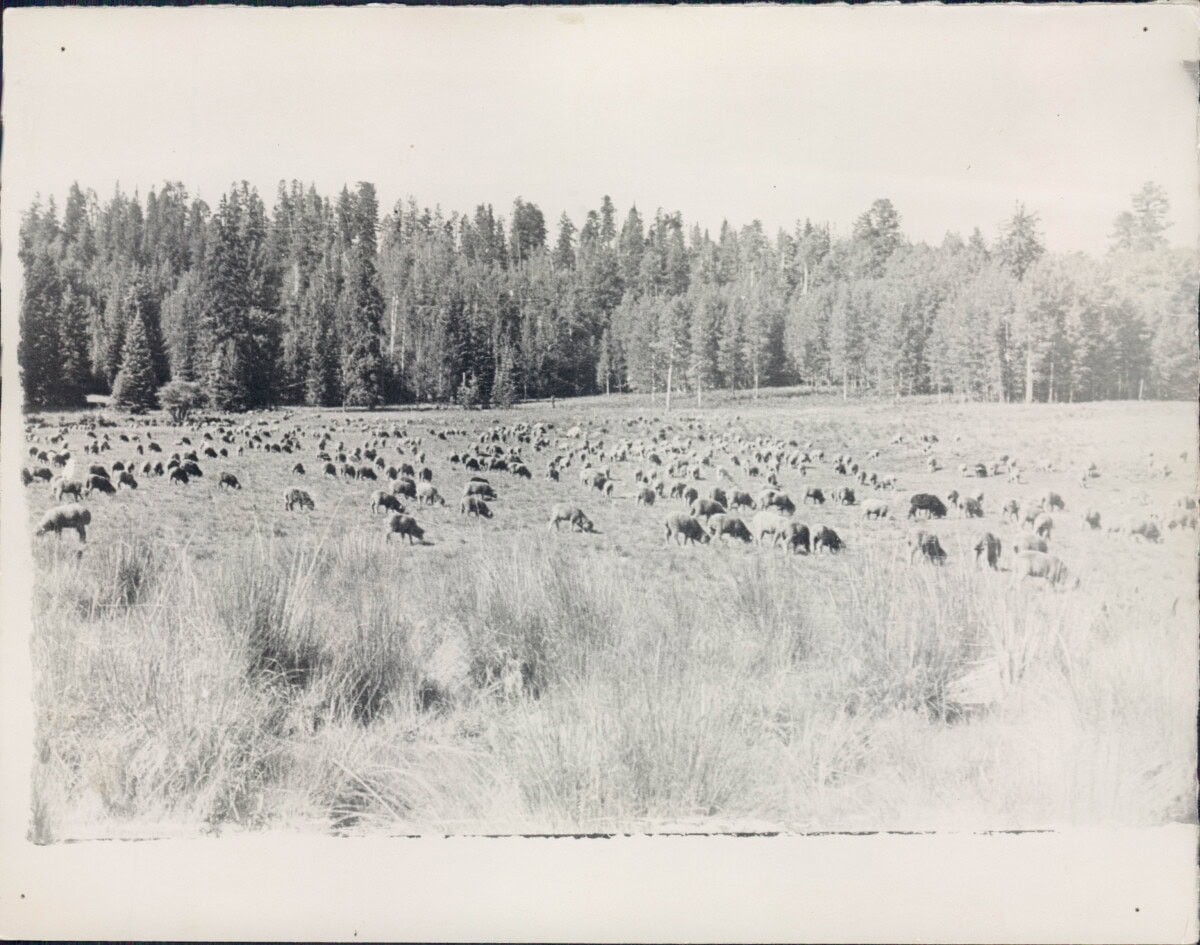
Cattle, and Sheep Ranching
The first ranchers who settled the Pinetop-Lakeside area included Will Amos, William Morgan, the Scott brothers, the West family, Jim Porter and a man named Warren. There were no boundaries, so ranchers ran their cattle and sheep on the open range on public land and the Fort Apache reservation.
photo id: 357
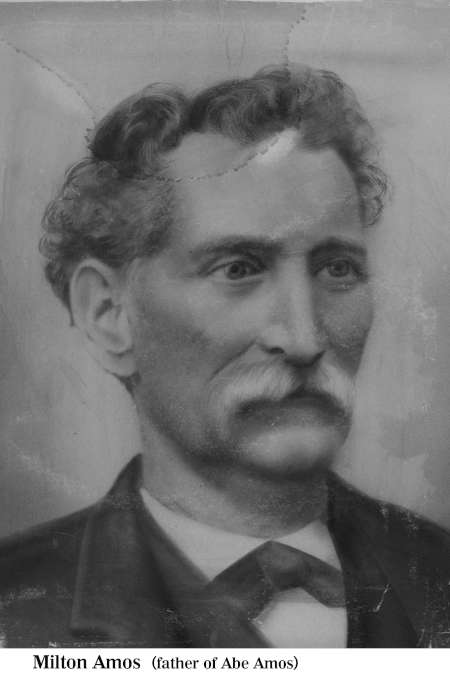
Milton Amos
Milton Amos was born in Kentucky between 1827 and 1830 and died between 1885 and 1887 in Arizona.
It is said that after he married his wife Allie, they started their life in Missouri and then migrated to Salinas, California and then to Roseburg, Oregon.During this time Milton was a Union soldior during the Civil War and is listed on census records as being a framer.
In 1884 their eldest daughter,Josie, was to have been married, but she died in the same year. According to Della, another daughter, a few years later Milton pulled up stakes and moved to Arizona.
According to family history, Milton, who was a heavy drinker, died in Holbrook soon after arriving in Arizona.
photo id: 233
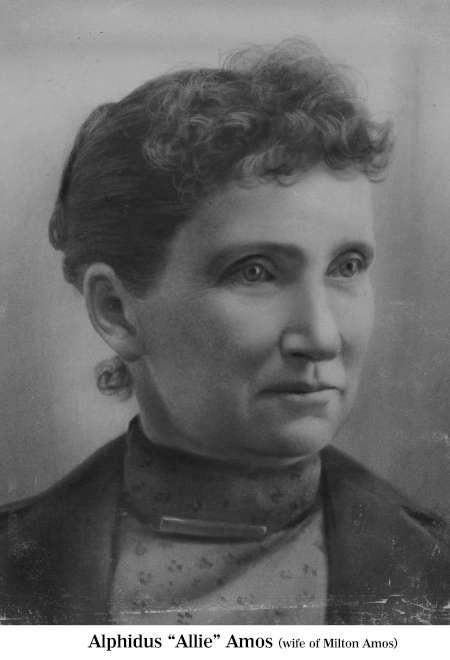
Allie Amos
Here is a picture of Alphidus “Allie” Fanny Willkinson who was born in Missouri on June 7,1841 and died in Arizona on March 20,1939.
Some time between 1860-1862 she married Milton Amos from Kentucky. They lived in Missouri, Oregon, and California before finally settling in Arizona.
They later had seven children: William “Will” Nathanial, Josephine “Josie”, George Washington, Abraham “Abe” Lincoln, Charles DIckens “Dick”, Della, and Leonard “Len” Earl.
photo id: 232
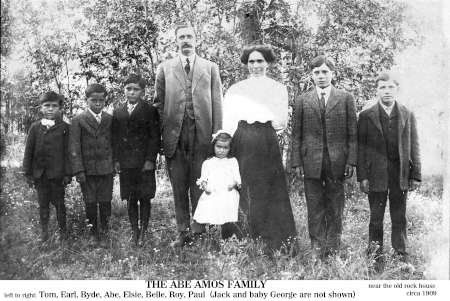
Abe Amos Family
Early in 1894 Abraham “Abe” Amos met and married Belle Crook Cooley. Belle was the oldest daughter of noted Arizona pioneer Corydon Eliphalet “C. E.” Cooley and his full-blood Apache wife, Mollie.
Abe and Belle met at a dance. Belle was dating a man named Colbath at the time, but quickly fell for the handsome young Abe Amos. When they were first married they lived at the old Welch place about where the Pinetop Country Club is now. From there they moved to Woodland. Their first two children were sons; Roy (born 1895) and Paul (born 1896) were small when they lived there.
To supplement their meals, Belle would shoot wild turkeys and hang the meat in a tree until needed. Bears would often steal the meat before it could be used.
photo id: 216
photo id: 232
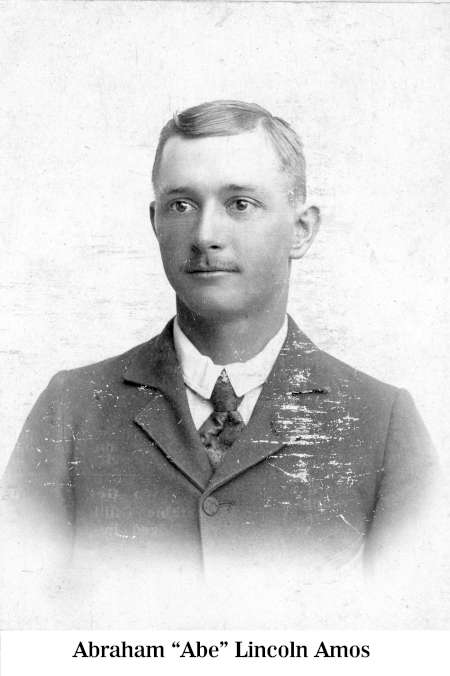
Abraham Lincoln Amos
It is said that one time Pinetop was to have a big party but the town had no liquor. The historian, Tom McGuire, wrote that Abe offered to ride to Holbrook on horseback and buy booze for everyone. The trip was done in one day, which to all the townsfolk was an unusual yet welcome surprise.
Abe was also one to delight the children of the area. He would use a pair of goats and a toy wagon to haul them through the streets. Abe went into the sheep ranching business and had a 160 acre ranch in Woodland (now part of Lakeside).
photo id: 220
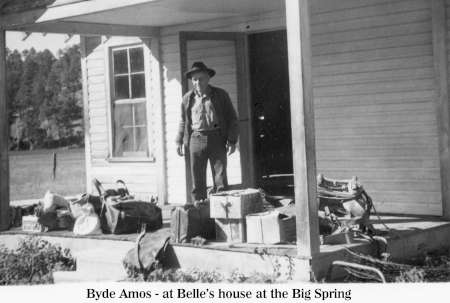
Belle Amos’ House at Big Spring
Belle Amos was half Apache; she had long black hair and black eyes. Her father sent her to a boarding school in Santa Fe, New Mexico, where she received a good education. She spoke the Apache language just as fluently as English. She was good-natured and always seemed to have a happy disposition no matter what hardships she faced.
When she was young she played the organ at the Cooley Ranch for the officers and dignitaries who would stay there. She was also a telegraph operator for the Cooley Ranch when it was an official way station for the Army at Fort Apache.
She lived most of her married life on a ranch. She was alone with her children much of the time, while her husband Abe herded sheep. She was a hard worker and was always sweeping and cleaning. She would wash for the whole family using a washboard. She loved to pick wildflowers and kept a big bowl of flowers on the table in the living room.
One of her prized possessions was an Edison Victrola that played music on the early wax cylinders. One of the songs she played on it was “The Moon Has Its Eyes On You” by Ada Jones from 1905.
photo id: 223
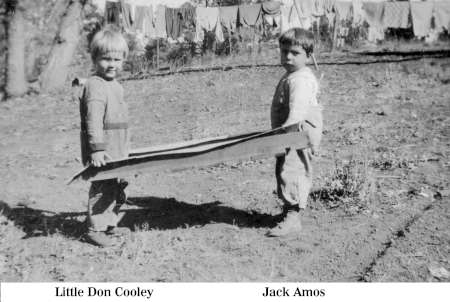
Amos Children With Their Toys
Pictured here are the children of Paul and Merintha Amos. What follows is a story about their dad, Paul Amos, and their Uncle Jack and Grandpa Abe:
Young Paulie and Jack Amos were driving their pickup truck down a forest road when they came upon their Grandpa Abe Amos riding a horse. After stopping to talk, it was decided that Abe would turn his horse loose and ride on with the boys.
After traveling a short distance they came upon a flock of wild turkeys crossing the road. As young boys will do, they sped up to scare the turkeys out of the way. The turkeys scattered and flew in all directions.
As one rather large bird flew by the passenger side of the truck, Abe quickly reached out and caught it in his hand. He then tossed it in the cab of the truck.Sixty-five years later, Paulie Amos still recalls with vivid clarity how that turkey nearly beat them all to death with its flapping wings.
photo id: 226
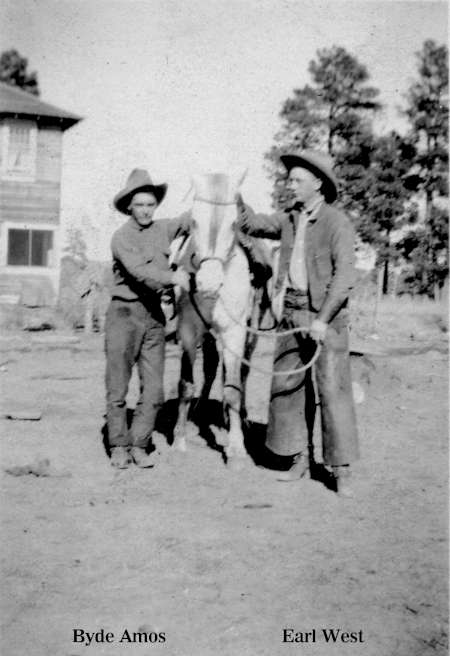
Earl West & Byde Amos at the West Hotel
Here we see Byde Amos and Earl West pictured with the West Hotel in the background.
In 1914 Ezra purchased land in Lakeside from John L. Fish and started to build a large home with the intention of using it as a hotel. The home was far from completed when the family moved in. Everyone had to pitch in and help until it was gradually finished.
Karl West designed the 19-room floor plan (possibly based on his grandfather’s home in Snowflake). It was a two-story building with nine bedrooms, one bath and a balcony upstairs; and four bedrooms, a bathroom, a kitchen, pantry, and two porches downstairs. There was also a large living room and dining room with a large fireplace. The family and hotel guests spent many memorable evenings singing and having get-togethers.
photo id: 241
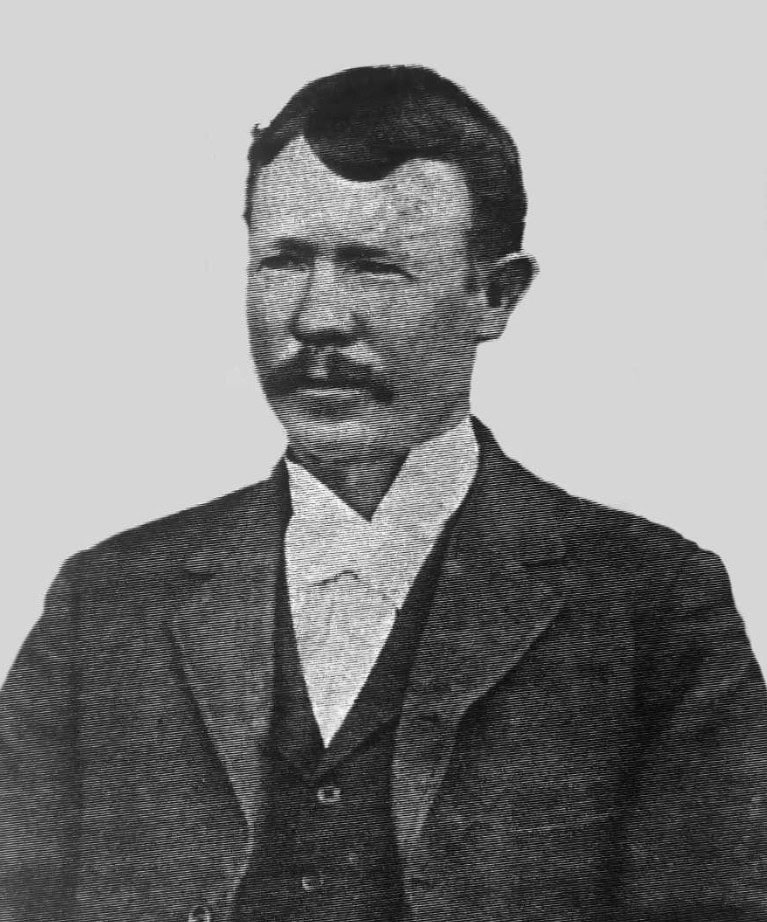
Samuel West
Samuel “Ezra” West and Julia West came to Woodland (now part of Lakeside) with their five children in 1897. Both Ezra and Julia were from noted Mormon pioneer families. Ezra’s father was John Anderson West of Snowflake and Julia’s father was Edmund Lovell Ellsworth of Show Low. The West and Ellsworth families first arrived in the White Mountains of Arizona in 1880 along with the influx of other early Mormon pioneers.
After getting married Ezra and Julia settled in Snowflake where Ezra’s father gave them land on which to build a one-room cabin. There they began their own sheep ranching business. Ezra learned the business from his father and had been tending his family’s sheep since the age of nine.
Right from the start of their marriage Ezra had to spend a great deal of his time away from home herding the sheep. Even so, during the next 11 years five children were born to the West family. The children were Emma, Joe (Ezra Joseph), Karl, Ida, and Dena.
photo id: 246
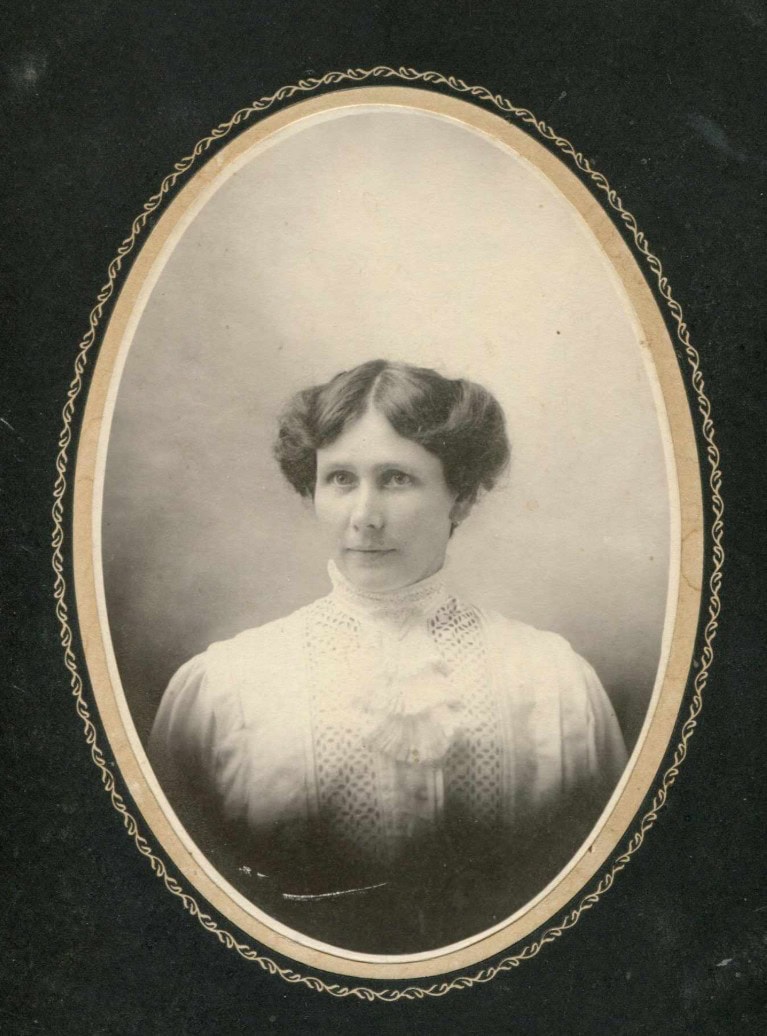
Julia West
Ezra and Julia first met at a church meeting and eventually fell in love. She was 16 and he was 19 years old when they decided to get married in 1886.
In those days for Mormon couples to be married in the church, they had to travel by wagon to the nearest temple. In this case, the closest temple was in St. George, Utah. The road they traveled along to get there was known as the Honeymoon Trail.
Their daughter Dena was born in July of 1896. The family moved to Woodland (now part of Lakeside) when Dena was still a baby. They bought a 160-acre ranch from Abe Amos. Abe’s daughter Elsie would one day marry Ezra’s son Earl.
The family all pitched in to help clear the stumps, trees and rocks from the land. Soon they were able to raise sheep, goats and cattle. While living here four more children were born: Lavern, Earl, Mary and Gwendolyn.
photo id: 303

West Hotel
Here is the first and last hotel to operate in Lakeside. However, the town has now been incorporated to Pinetop-Lakeside, and you can now find several hotels in the Pinetop area.
In 1914 Ezra West purchased land in Lakeside from John L. Fish and started to build a large home with the intention of using it as a hotel. The home was far from completed when the family moved in, however. Everyone had to pitch in until it was gradually finished. Karl West designed the 19-room floor plan (possibly based on his grandfather’s home in Snowflake).
It was a two-story building with nine bedrooms, one bath and a balcony upstairs; and four bedrooms, bathroom, kitchen, pantry, and two porches downstairs. There was also a large living room and dining room with a large fireplace. These rooms were used by the family and guests for evenings of singing and playing games. The family spent many happy years running this hotel for travelers.
photo id: 102
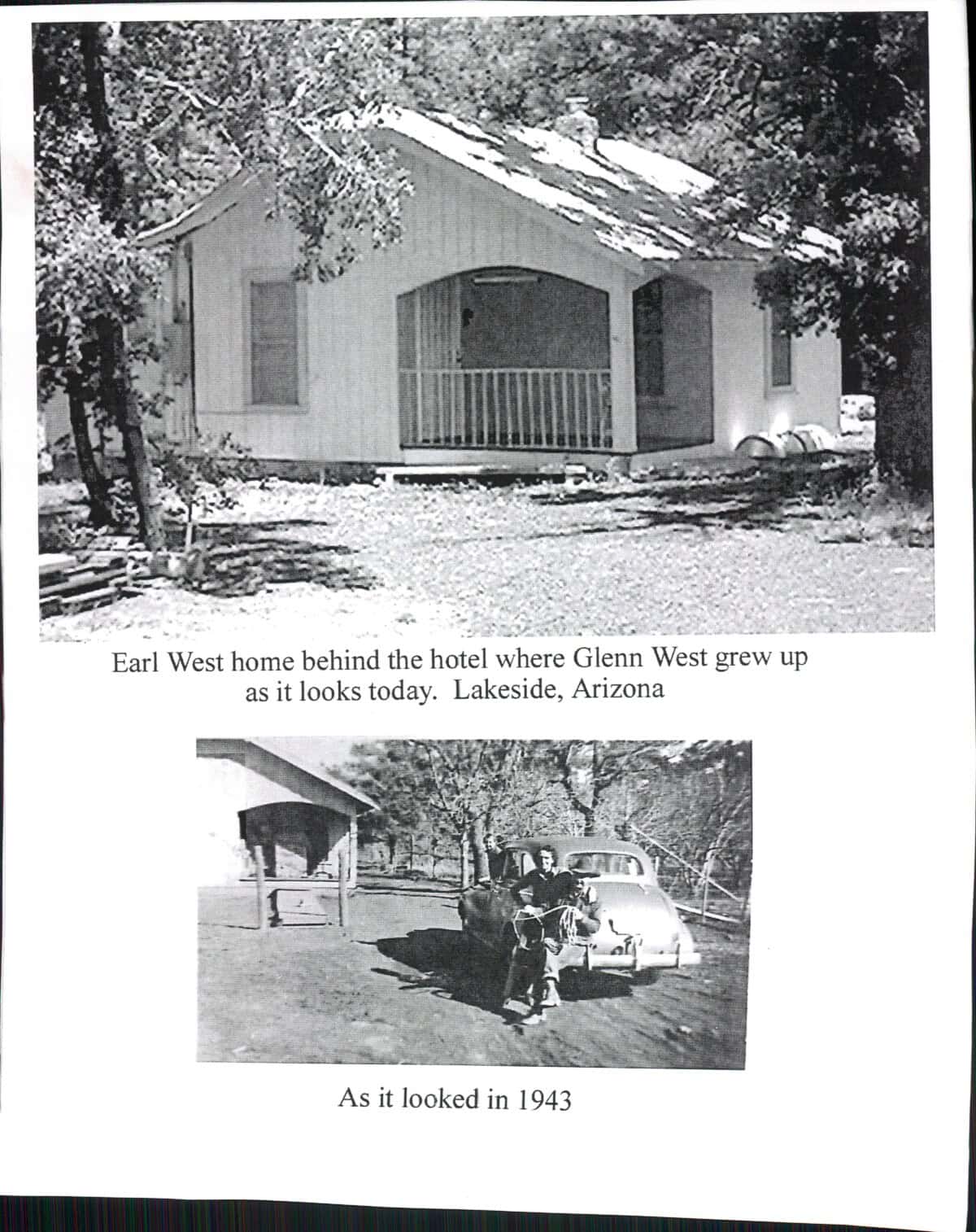
Earl West’s Home
The youngest West son, Earl, was given a corner lot in Lakeside to build himself a home. The old Woodland ranch was sold to their other son, Lavern. Earl West’s home was beside the hotel where Glenn West grew up.
Joe “E. J.” West was the family entrepreneur. He became a builder and store owner in Lakeside, Show Low, Snowflake and Taylor. He also owned construction companies in San Diego and Phoenix. At different times he was also in the dairy business, a rental business, and served as an executive of an insurance firm. During the 1930s and 1940s his Blue Moon Dance Hall and Cafe in Show Low was the number one place for entertainment in the White Mountains.
photo id: 104
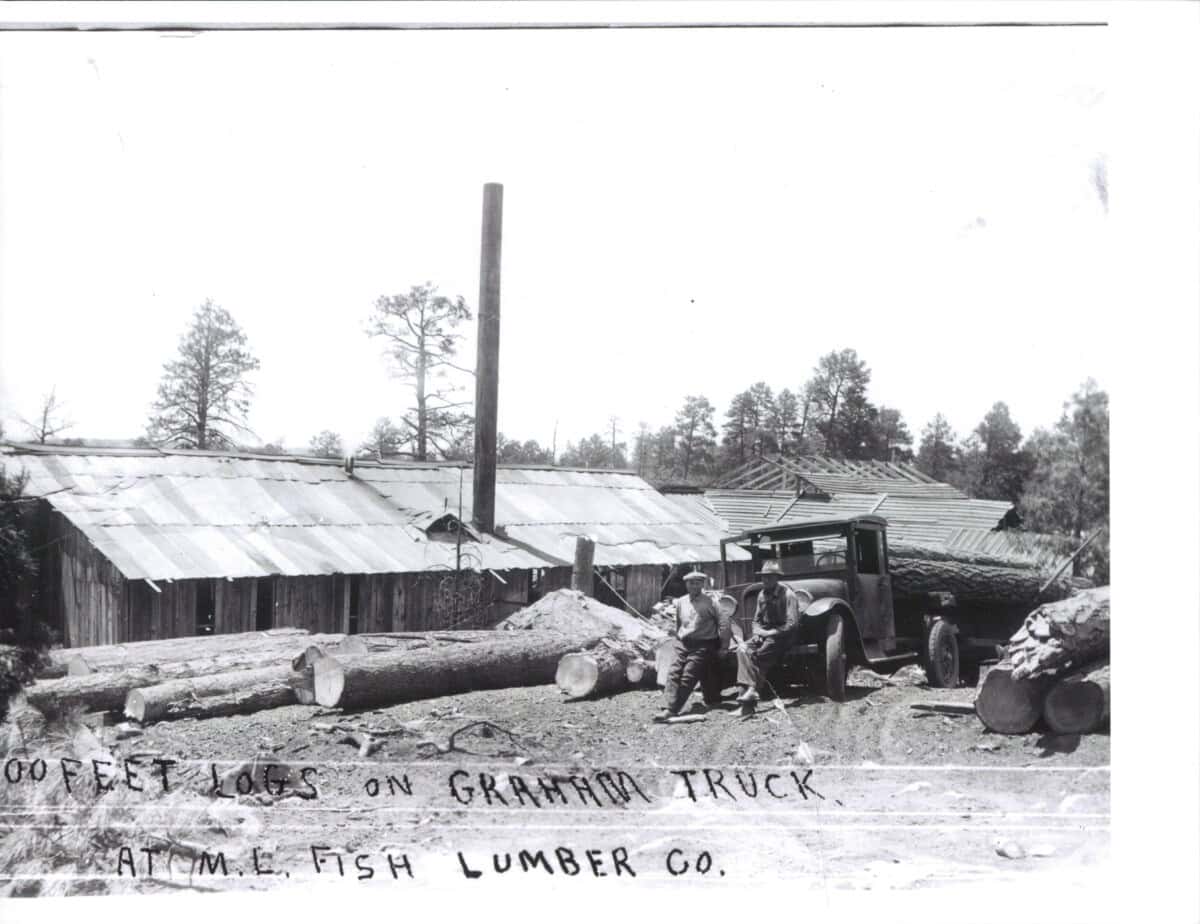
Lakeside Outing
Early Lakeside settlers taking a break from their hard work.
photo id: 495
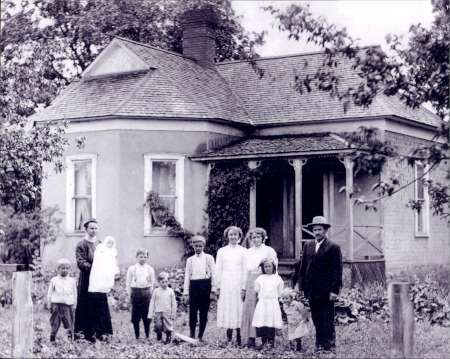
Neils Hansen Family
Pictured are Neils and Rosabel Gardner Hansen and their children. Neils S. Hansen was born in 1869 and died in 1933. Rosabel was born in 1875 and died in 1942. Considered the “Father and Mother of Lakeside”, they purchased the Will Amos homestead upon coming to Lakeside in March 1906. They encouraged other families to move to Lakeside, too.
Neils previously built the orginal home for Amos for around $350. He made the adobe bricks for the home himself, which is still being lived in today. Their bunkhouse became Lakeside’s first school. Neils was also a skilled ditch surveyor. He surveyed the irrigation ditch from Lakeside to Show Low. He was also an excellent farmer.
Rosabel, known to many as Aunt Belle, was the mother of eleven children. Twelve loaves of bread were baked each day and buckets of milk had to be strained in order to feed everyone. She brought music to Lakeside, teaching with the tuning fork.
Shown here are Erwin, Rosabel holding Charles, Don, George, Junius, Irma, Ernestine, Anna, Marion, and Neils.
photo id: 410
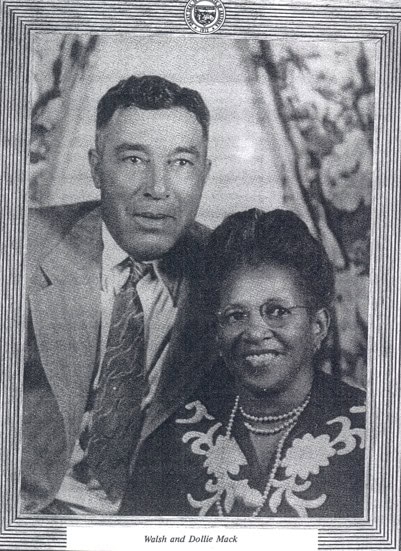
Walsh Mack
Walsh Mack owned and operated the Dew Drop Inn and later the Pinetop Buffet and Bar-B-Q. The Lions Den is now located there.
Walsh Mack was born in Franklin Parish, Louisiana on July 11, 1891. He came to McNary in the 1924 and worked for the Southwest Lumber Company. In 1938 he brought property from Mable Bowles, Thelma Axeline’s grandmother. Mable Bowles was the only landowner willing to sell to an African-American couple. Some of the local people were enraged by the sale.
Not long after that their building was burned in an attempt to run them out of town. The Macks rebuilt and opened a small cafe with a barbecue business. Nine years later Walsh Mack and his wife had a grocery store, cafe, and liquor store that grossed $200,000 annually.
photo id: 373
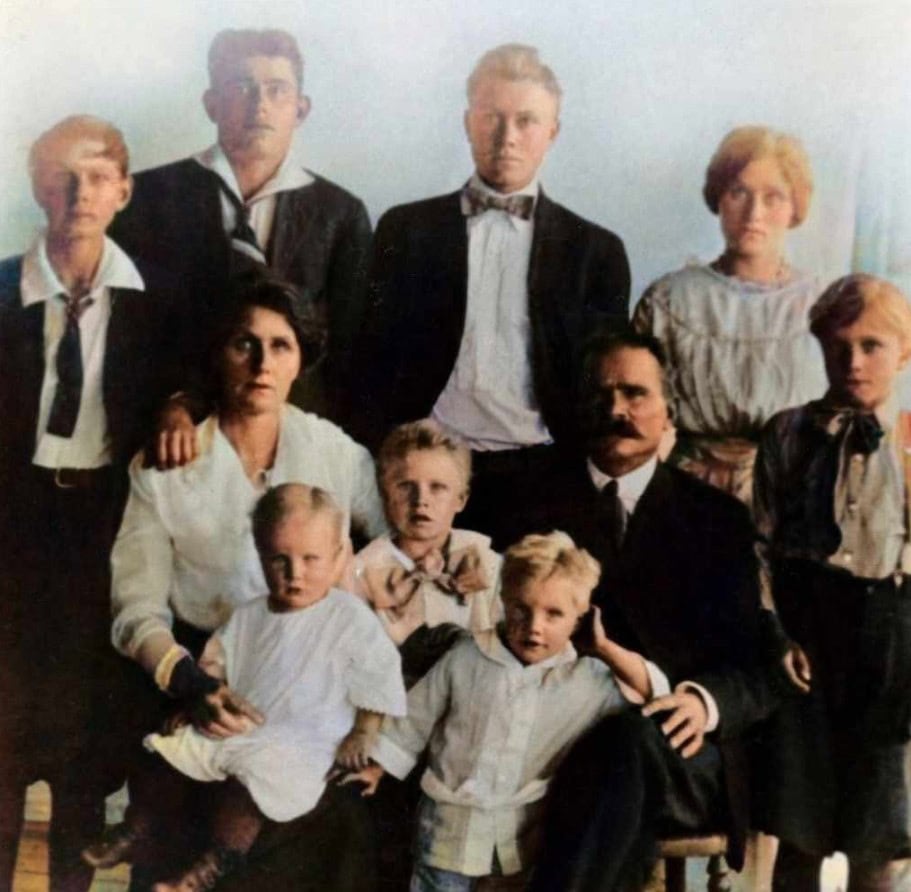
The John Washington Adair Family
John Washington Adair faced many sorrows in his life. He burried his wife and 11 of his 12 children. The book entitled “The John Washington Adair Family : Descendants” recounts some of these tragic deaths and family events.
Thelma Glaydis, their baby, died during the flu epidemic of 1910. John Robin died while on summer vacation fighting a forest fire when a burning tree fell on him. Lloyd Edwin, born in 1904, drowned in a creek in 1948.
After John’s wife Cynthia died on October 10,1951, it was only four short year later that the house burned down. John then moved in with his only child, Genevieve, who lived in Holbrook. John died in 1957.
photo id: 413
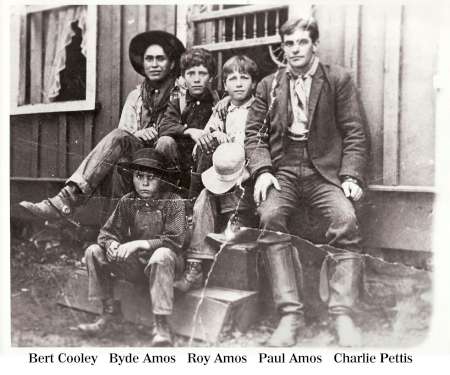
Three Pioneer Families
Pictured here are members of three pioneer families: The Cooley, Amos, and Pettis families.
A young Roy Corydon Amos is pictured here. Roy who was born April 23,1895 near Cooley’s Ranch. He was one of three of Abe’s children to die prior to marriage. His untimely death occurred while walking out for supplies in winter on February 3,1939.
Not pictured are the two other Amos children who perished during childhood: Earl Logan Amos drowned at the age of 19, and George Amos died on February 8, 1909 at the age of four months.
photo id: 229
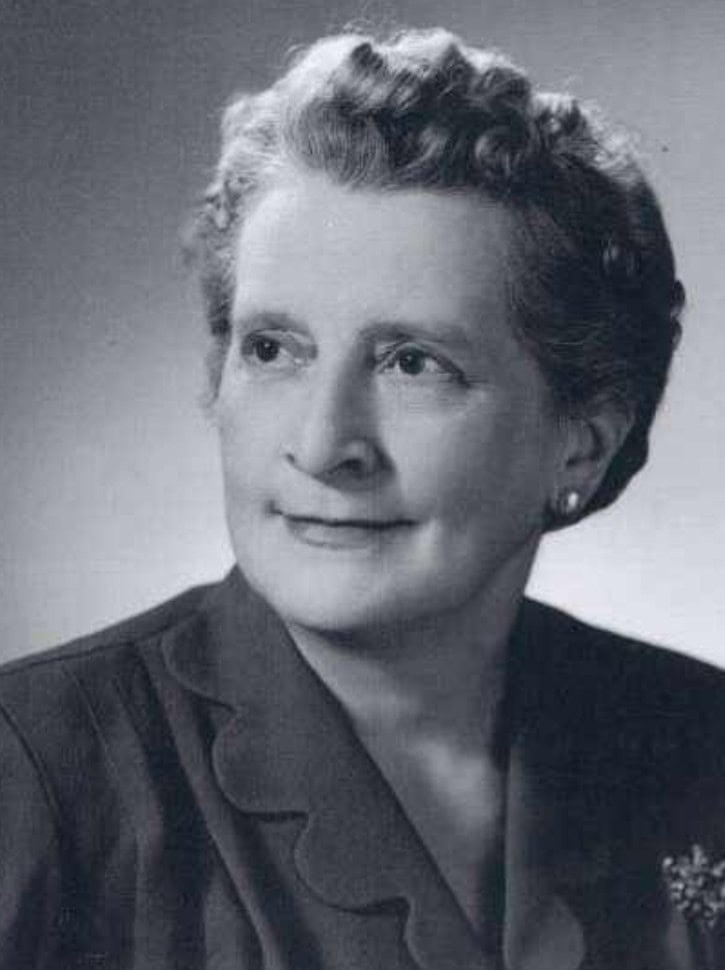
Augusta Treat Larson
Augusta “Gussie” Treat Larson was born in Flagstaff, Arizona on February 6,1893.
Gussie was a lifelong resident of Arizona whose formal education began in a private kindergarten at the age of two and a half. By age eighteen she had earned a teaching degree and embarked on a teaching career that spanned for decades.
In 1954, Augusta was appointed to the House of Representatives to serve out the unfinished term of her husband. She was subsequently elected for four more terms.
photo id: 339
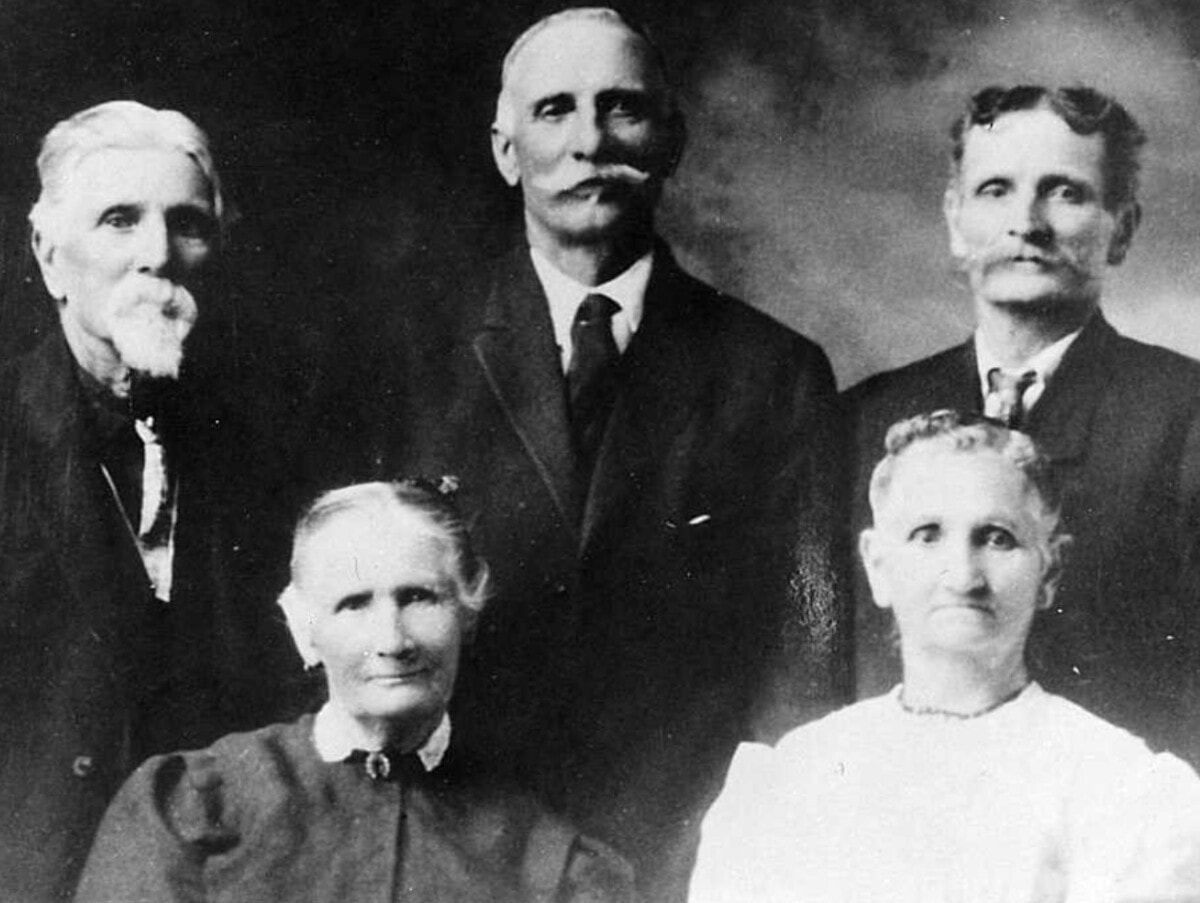
Penrod Family
The grown children of David and Temperance Penrod: William Penrod, David Nephi Penrod, Amasa Lyman, Elizabeth Wall, and Temperance Evans.
William L. Penrod, one of David’s sons, was born on January 27,1832 in Union County, Illinois. He moved to Utah in 1849 where he married Polly Ann Young. The couple had twelve children.
On October 26,1876 William and his wife were called by the Church of Jesus Christ of Latter-day Saints to help colonize Northern Arizona.
They arrived in the White Mountains on December 31,1878 and camped in an old house belonging to a sheepherder.
In the summer they moved to John Willis Ranch and looked after the cattle. He later moved his family to Juniper, now known as Linden, until the rumor of the Apaches causing an uprising made him move to Cooley ranch. This was the beginning of Cooley and Penrod’s friendship.
photo id: 411
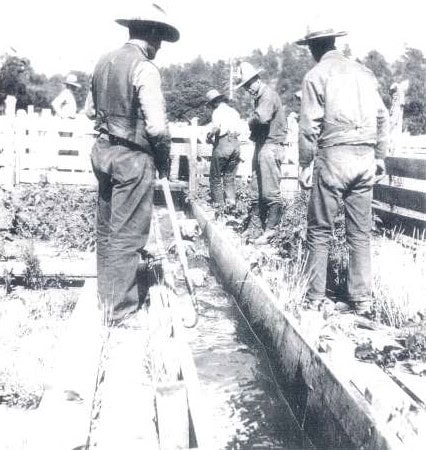
Sheep Dip Structure
This is a picture from the late 1800s of a sheep dip structure owned by the Jacques Family. It was located on Timber Mesa, southwest of Porter Mountain.
The Spanish Conquistador Francisco de Coronado paved the way for the eventual colonization of the north. Colonist brought horses and livestock. Descendants of Spanish horses multiplied rapidly on the virgin grasslands of the West. In less than a century the Navajo and Apache became horse cultures. They dominated the Southwest and Northern Mexico during the 1700s and first half of the 1800s, taking captives and livestock to trade for more horses at the annual Taos trade fair. Spanish colonist along the Rio Grande called them Lords of the Land.
photo id: 356
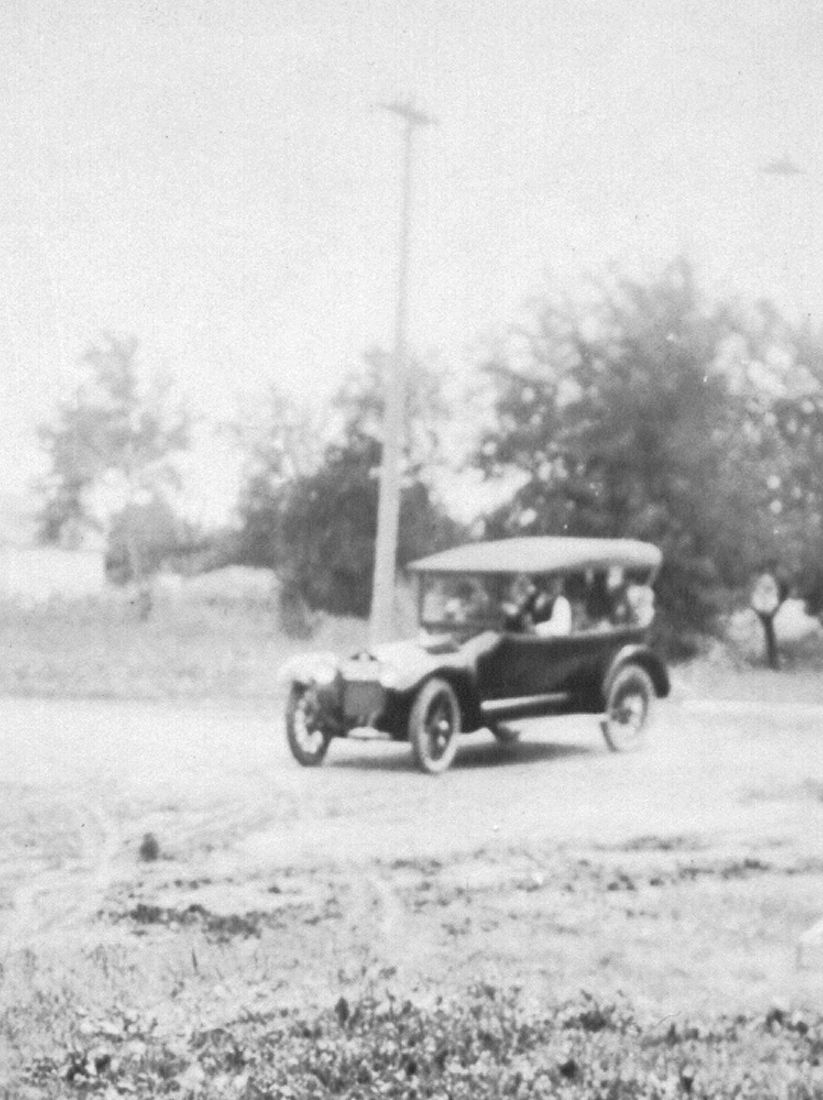
First Automobile in Lakeside
photo id: 250
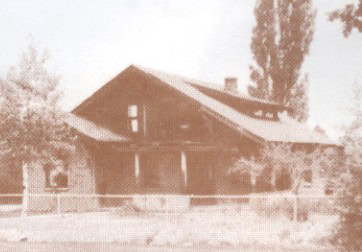
Old Post Office
John L. Fish bought out Billy Score’s claim to Lakeside. He became Lakeside’s first postmaster in October 1906. He also served as Justice of the Peace for Lakeside. He donated property now owned by the Church of Jesus Christ of Latter-day Saints, presently serving as the Pinetop- Lakeside Stake Center. He also donated the property one block south of there for the school, which later became the Town Hall, and where the Pinetop-Lakeside Historical Museum stands today.
photo id: 488
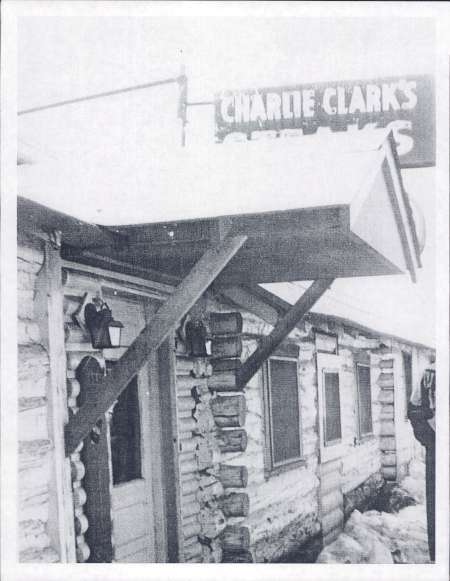
Charlie Clark’s Restaurant
Jake’s Cafe, which is now Charlie Clark’s Restaurant, was developed when prohibition was repealed. Jake moved two log cabins together and opened a legitimate business “Jake Renfro’s Famous Log Cabin Cafe.”
The story goes that there was an old wooden barrel under the barroom floor for his whiskey. It is also told that he brought in penny, nickel, dime, and quarter slot machines. Jake organized bands to play for dancing at the Log Cabins. Once in a while Sis got to entertain the customers by tap dancing.
Charlie Clark’s Restaurant is still a popular spot in the White Mountains.
photo id: 365
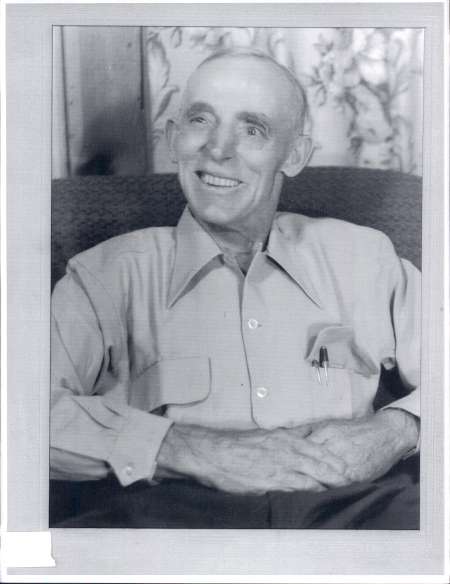
Charlie Clark
Charlie Clark came from Michigan where he had worked for Henry Ford. His wife, Bell Wilson, came from Ireland. They were married and had two children: Dolly (Crosby) and Buddy (Wise).
In 1938 Charlie bought Charlie Clark’s Restaurant from Jake Renfro. After the death of Bell in 1936, he married Thelma Rungee Wetzell in 1942.
photo id: 372
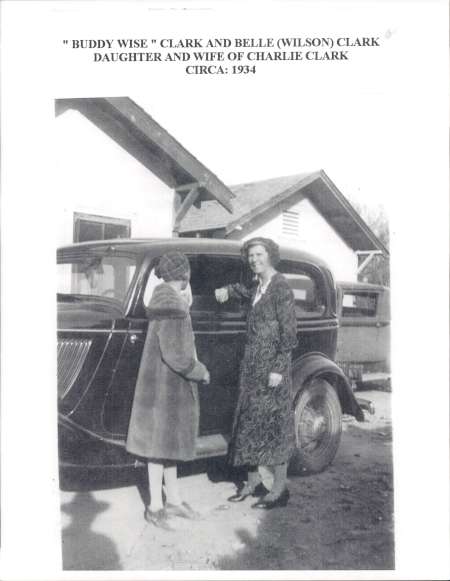
Charlie Clarke’s Daughter
Buddy Wise, one of Charlie Clarke’s daughters, purchased Elaine’s Dress Shop from Mildred Dysterheft. She divided the building so her sister could have half. That side was named Crosby’s. In the late 2000’s she sold the dress shop to the Baptist church.
photo id: 403
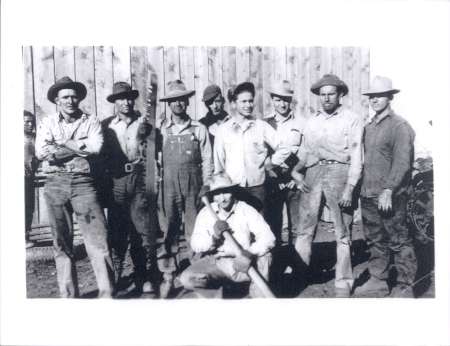
Webb Sawmill Crew
The Webb Sawmill Crew: Tom Frost, Karl Webb, Waldo Ray, Junius Webb, June Webb, Reece Webb, Fred McNeil, Jay Webb, and Ray Webb (kneeling) in the 1940s.
Two of the most noted families involved in sawmilling in the Lakeside area were the John L. Fish family, who moved to Lakeside in the early 1900s, and the J. H. Webb family, who settled in the area in the 1920s.
photo id: 414
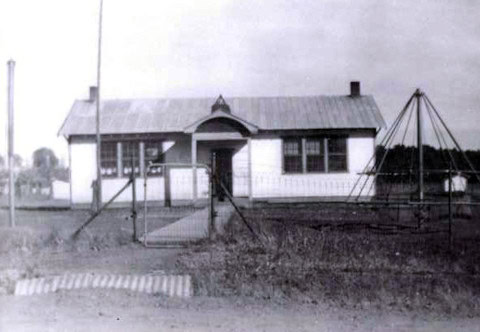
School & Meeting House
The school and meeting house in Lakeside Arizona.
photo id: 486
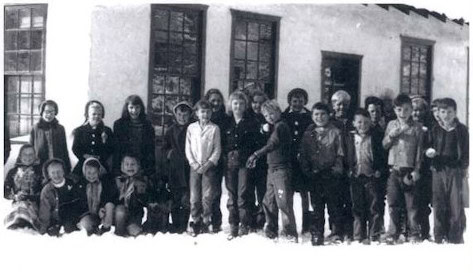
School Children in Lakeside
Students from the 3rd and 4th grades in front of their school in 1954-1955. This building is still standing in Lakeside and is occupied by the Pinetop-Lakeside Historical Museum.
Students standing from left to right are: Viola Hansen, Patty Frost, Grace Jackson, Cheryl Penrod, Sheila Jackson, Mary Ann Creswell, Lerian Lee, Beverly Penrod, Tommy Rhoton, Janet Heldt, Wesley Burke, Ricky Johnson, Stephen Penrod, David Gillespie, Lanny Johnson, Lanny Witt, Vivian Lewis, Lucille Clarkson, Cliff (Hoopie) Frost
Sitting left to right are: Dosea Webb, Iden Webb, Inez Prather, Bertha Clarkson.
photo id: 341
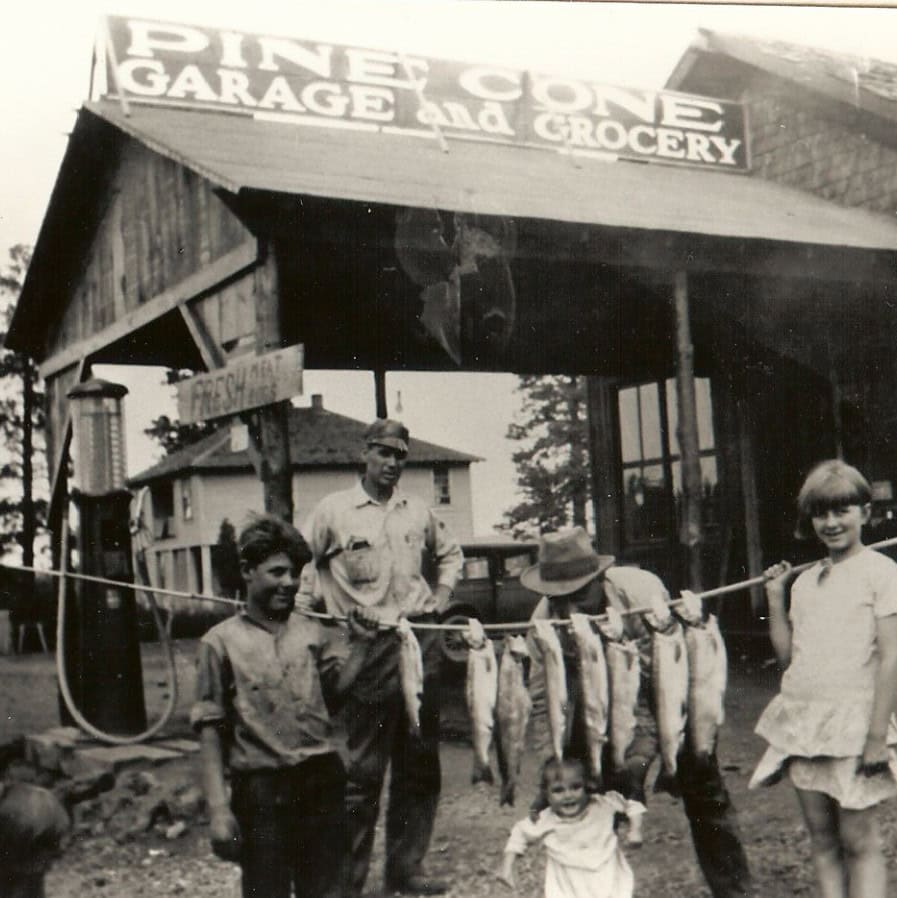
Pine Cone Garage and Grocery
Right next to the house/hotel in Lakeside a store was built by Joe West. The store was operated for many years by the West brothers at different times: Ezra, Karl, Joe and Lavern. This store was called the Pine Cone Garage and Grocery. Food, gas, and a little bit of everything else was sold there.
The West family also planted an orchard near the hotel. They would always have plentiful crops of apples, peaches, crab apples, plums, and gooseberries. They also had wonderful gardens there.
Four cabins were also built on the property to be used as rental units.
photo id: 484
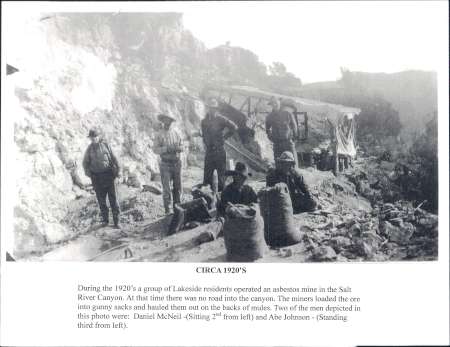
Mining
During the 1920’s a group of Lakeside residents operated an asbestos mine in the Salt River Canyon. At that time there was no road into the canyon. The miners loaded the ore into gunny sacks and hauled them out on the backs of mules.
Two of the men depicted in this photo are: Daniel McNeil (sitting, 2nd from the left) and Abe Johnson (standing, third from left).
photo id: 409
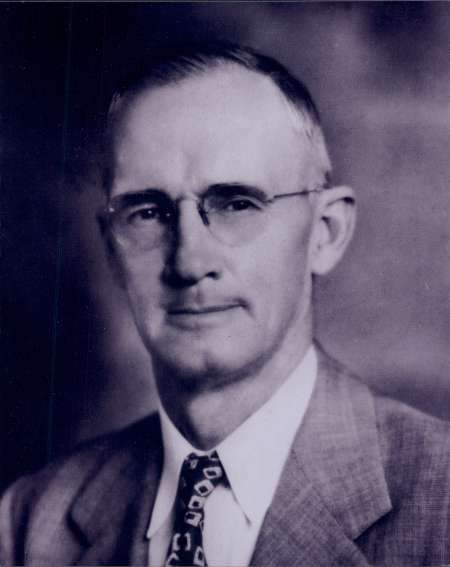
Wallace Hunt Larson
Here we see Wallace Hunt Larson in 1950. He was born in Snowflake on May 22, 1887.
He earned his education the hard way and then devoted his life to the education of the young people in his community of Lakeside. He worked for the general improvemnet of living conditions in all of Northeastern Arizona.
Over the years, he served at various times as Justice of the Peace, county recorder, deputy sheriff, and district game ranger. He was also in the cattle business. In 1952 he was elected to the State Legislature for Navajo County and was reelected the following year.
On June 20,1954 after working for 18 hours straight, he suffered a fatal heart attack. His wife, Augusta, was appointed as his successor.
photo id: 338
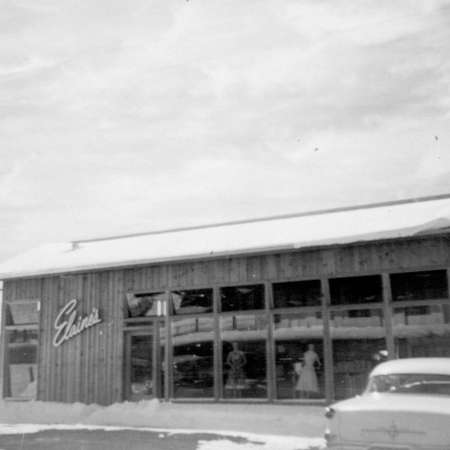
Elaine’s Dress Shop
In 1952 Mildred bought Elaine’s Dress Shop in Pinetop from Phyllis “Elaine” Dowd. Later she had a new Elaine’s built. She had fashion shows and local women would model the latest fashions. She could not keep enough clothes on the racks. Elaine’s is now owned by Buddy Wise.
In 1971 Mildred started selling real estate for Pearl Penrod Reality. Later she obtained her broker’s license. She owned D&H Realtors and a beauty shop that was in the same building. The “D” was for Dysterheft and the “H” was for Lyle Hanna.
photo id: 390
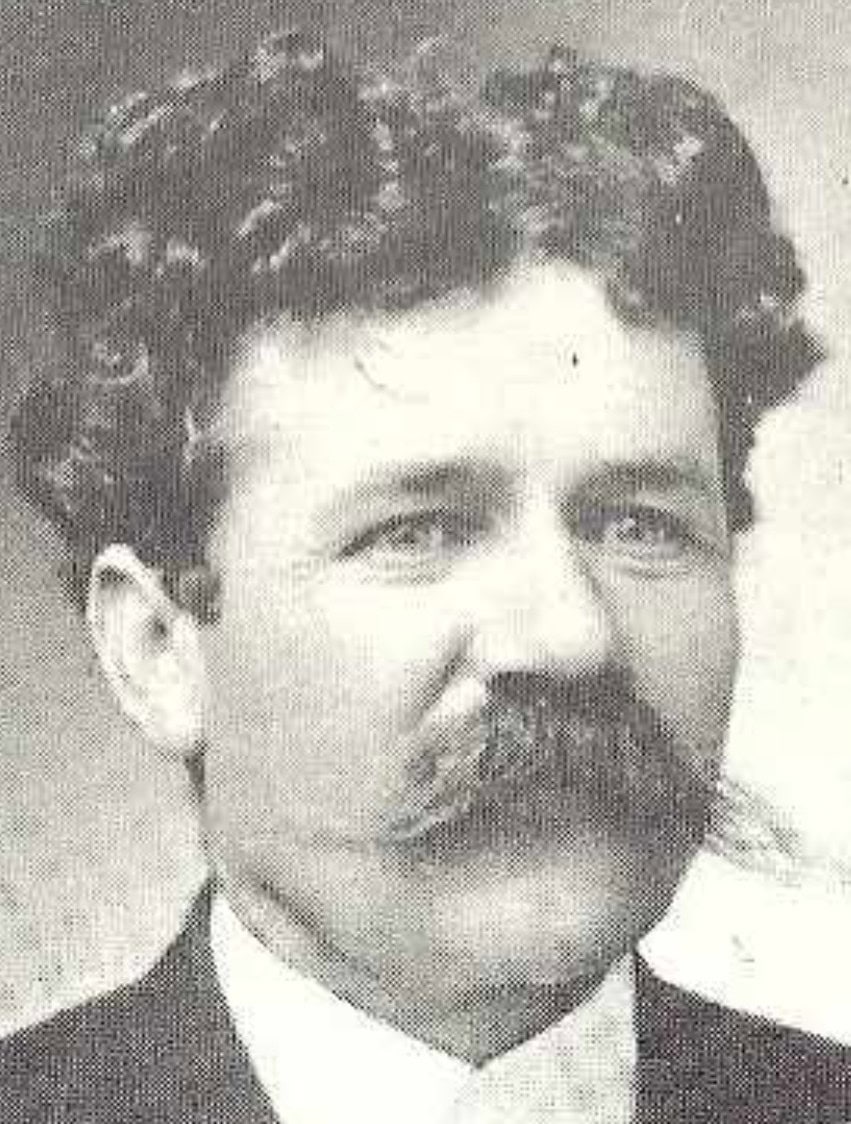
Hans Hansen’s Home
photo id: 979
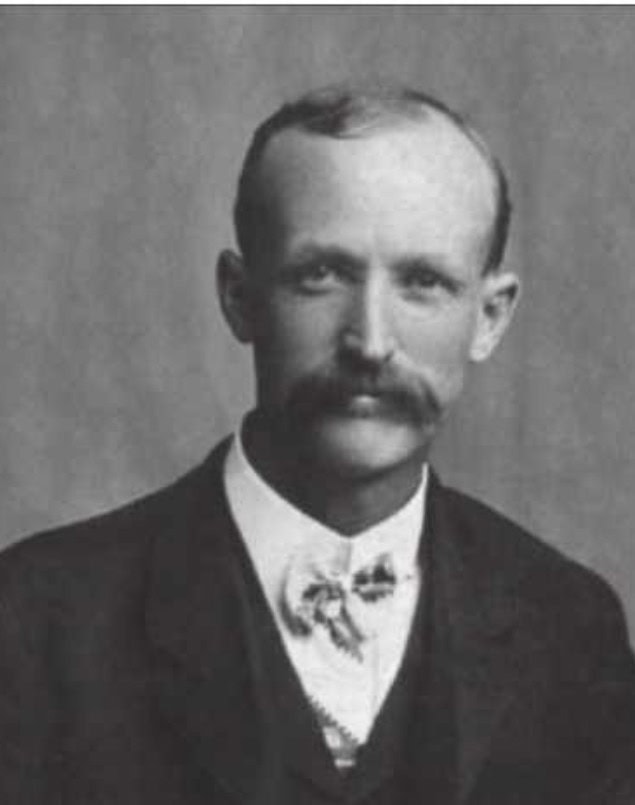
John L Fish
photo id: 994
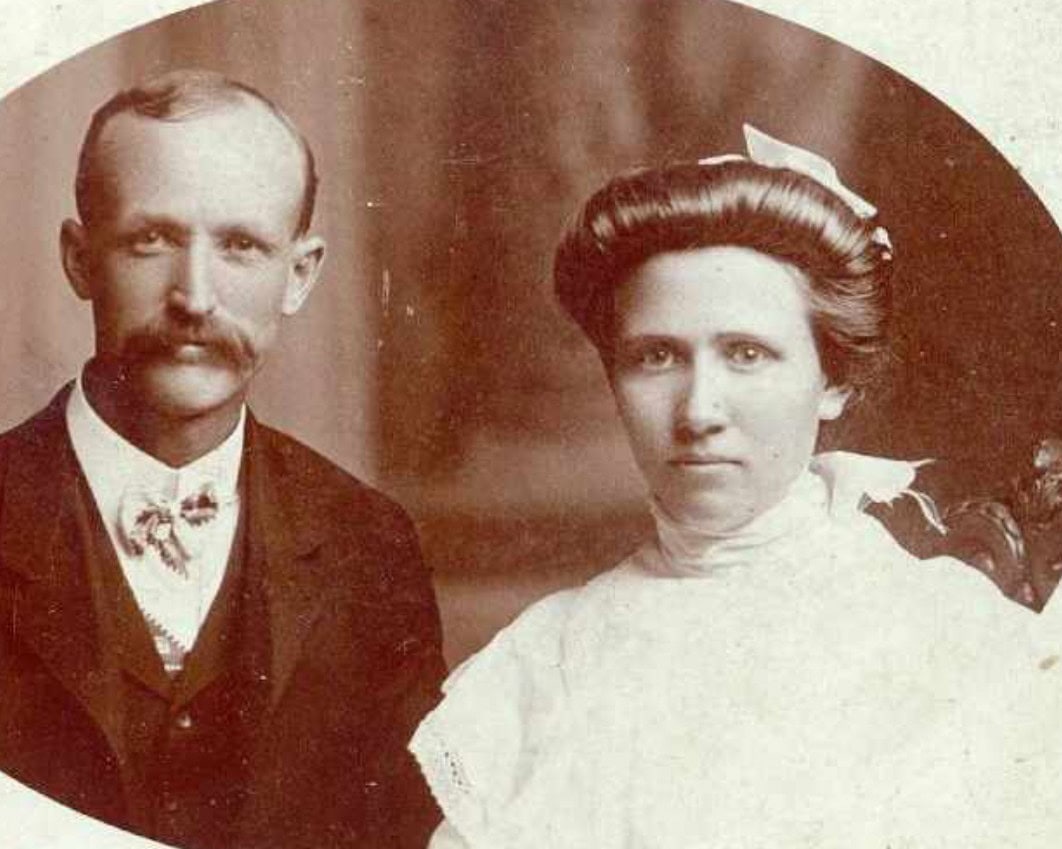
John Fish & Julia Tanner
photo id: 995
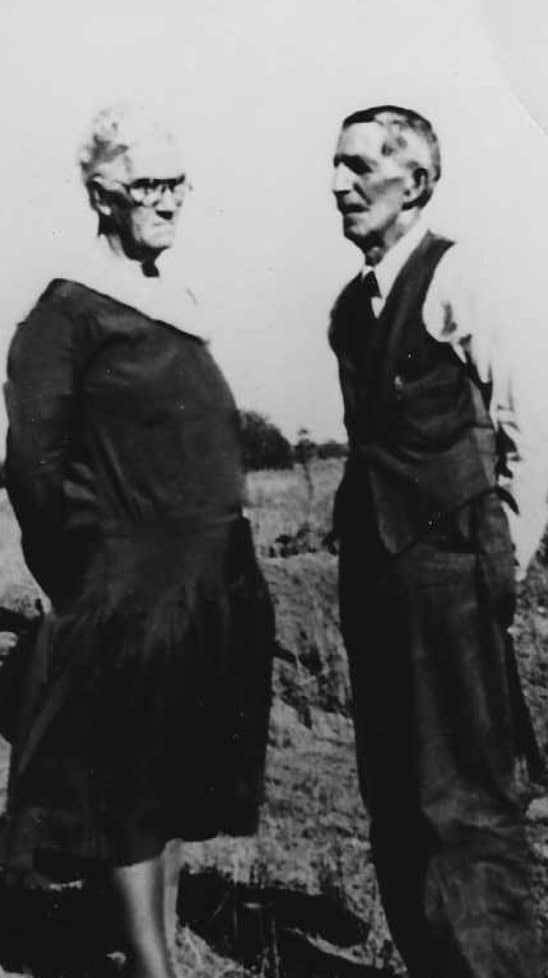
The Hansens
John Heber Hansen (1859-1945) and his wife Emily Hansen.
photo id: 1001

Theresa Johnson
Theresa Flake Johnson in 1933.
photo id: 1007
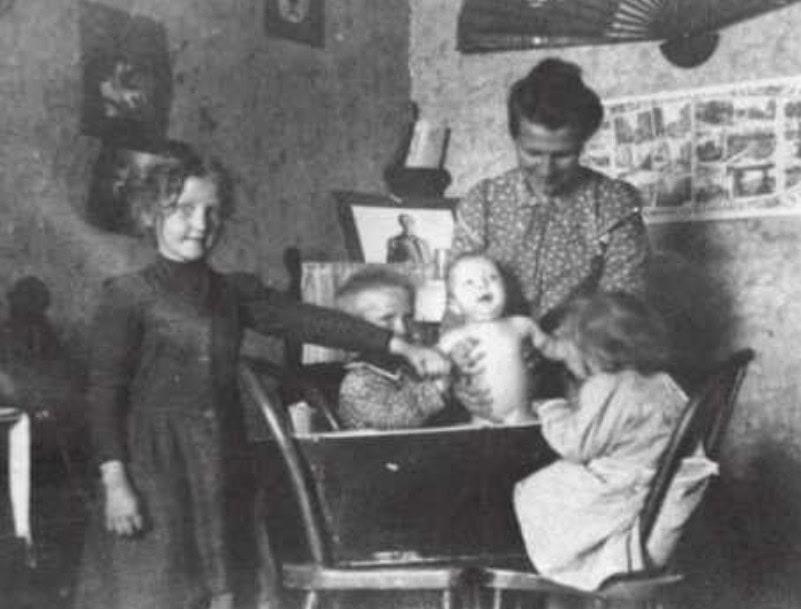
Julia Fish Russell
Julia FIsh Russell with her mother and siblings. Pictured are Julia, Hamilton Murray Fish, Eva Fish, mother Melvina Cheney Fish, and Karl Joseph Fish.
photo id: 1008
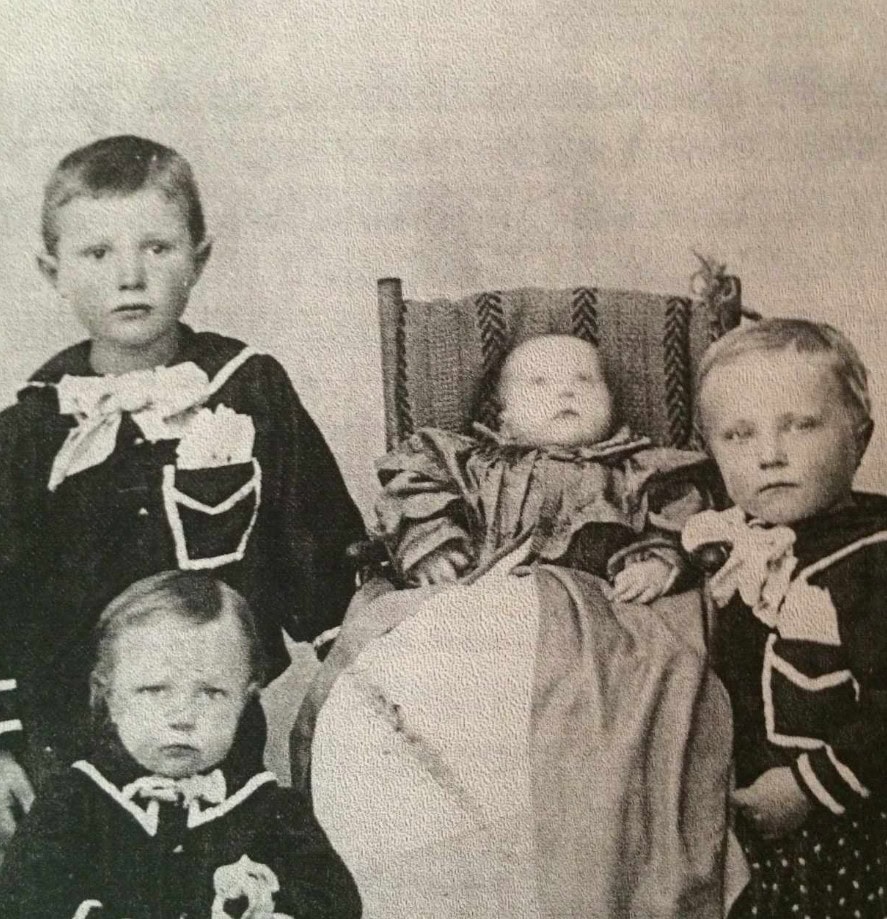
Siblings
Julia Fish Russell and some of her siblings.
photo id: 1009
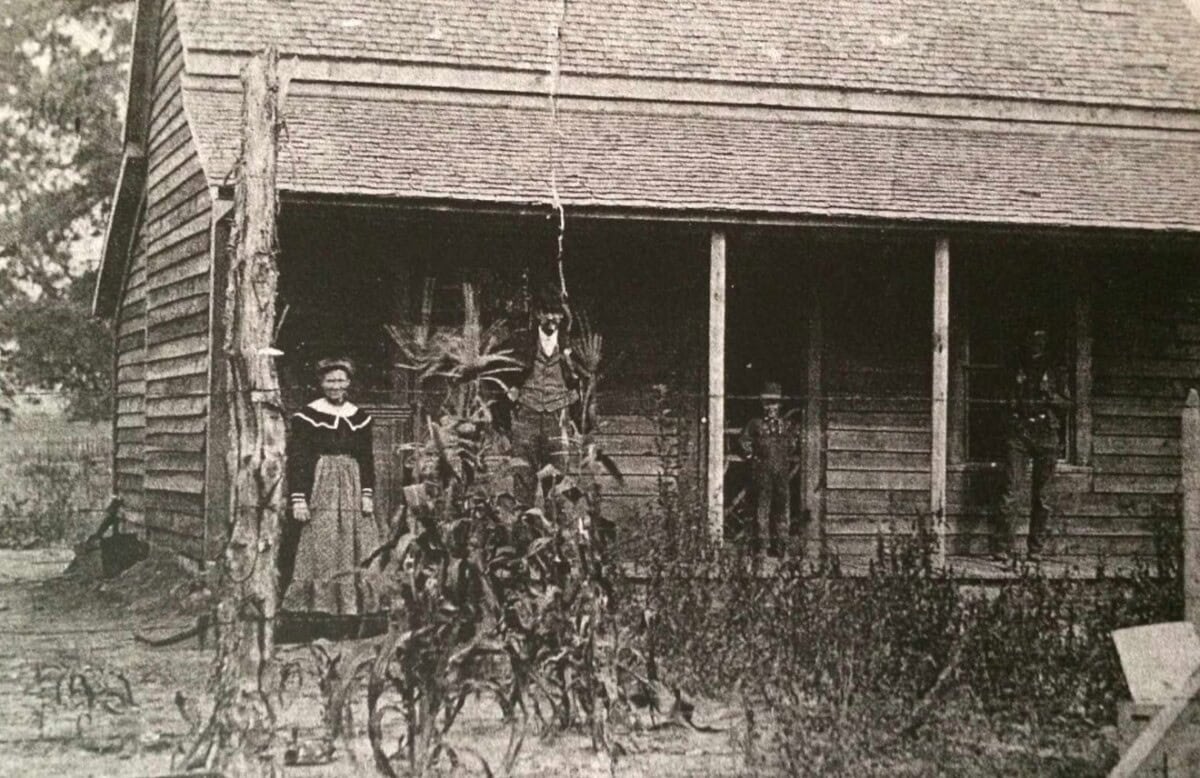
Fish Home
Julia Tanner Fish, John Fish, and Hamilton Fish at their home in Lakeside.
photo id: 1010
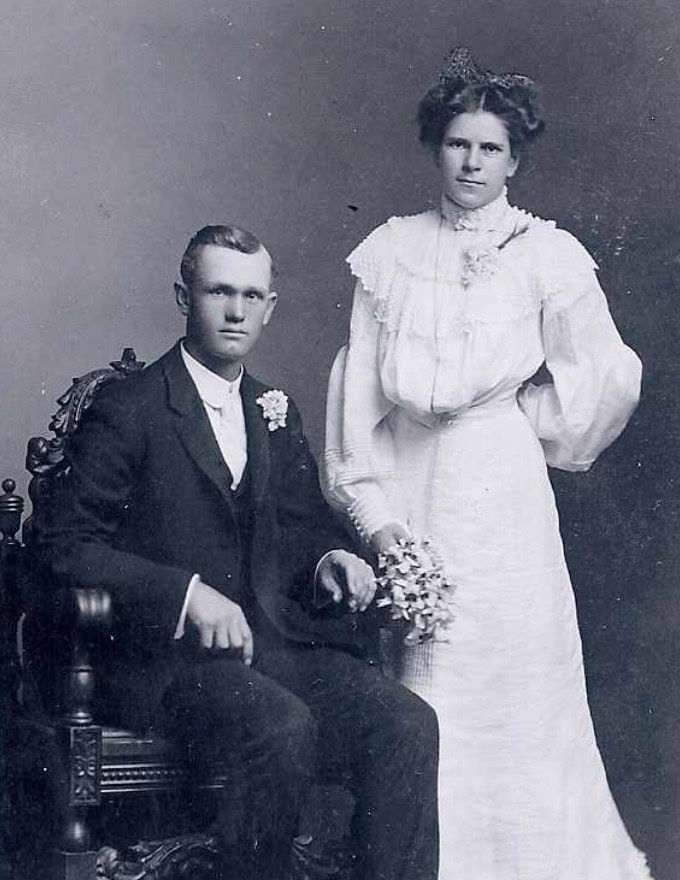
Alof and Margaret Larson
Alof Pratt Larson and Margaret Smith on their wedding day: June 1st, 1904.
Alof was born in 1883 and Margaret in 1884.
photo id: 1014
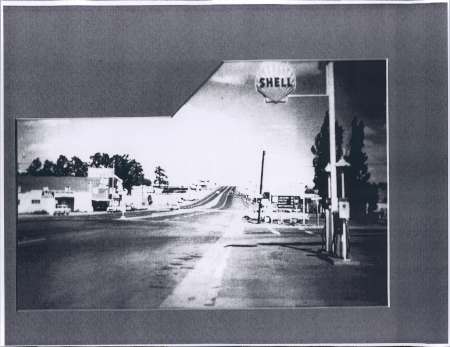
Main Street
This 1945 photograph, shows where today, in the twentieth century, you can find the Show Low Historical Society Museum. You are facing as if ready to drive to Springerville Arizona.
Back when this photo was taken you would have to drive to Springerville, Globe, St. Johns, or Holbrook to purchase your new Ford or Chevrolet. Today there are many popular car dealers in Show Low.
photo id: 198
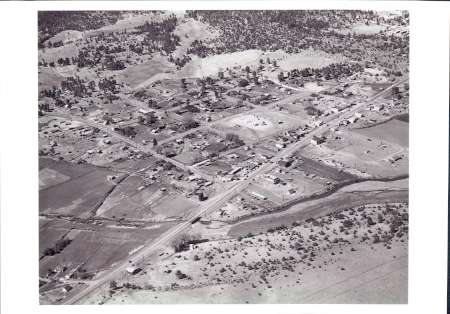
Aerial View of Show Low
Here we see an aerial view of Show Low taken in the early 1950’s.
The beautifully lush cattle lands in Show Low are similar to what you will find today. This is mainly due to many of the pioneer families descendants retaining ownership of their ancestral lands. You can still see well bred horses and cattle grazing in their pastures.
photo id: 195
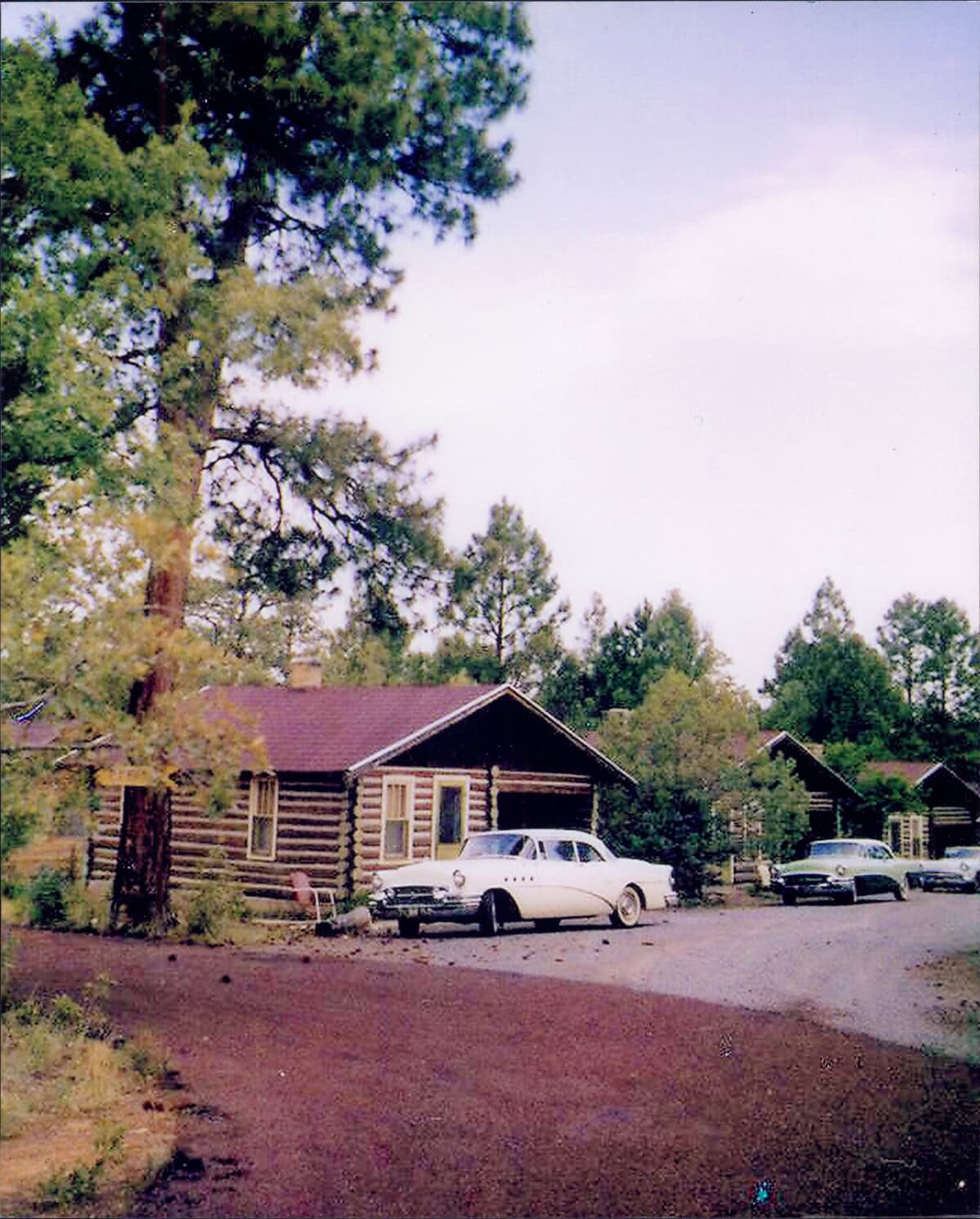
Fishing in the White Mountains
In what appears to be twin Buicks, these 1918 adventurers head out with a tent in the back seat of the front car and a doggie riding shotgun in the back car. Traveling through the mountains often requires navigating difficult terrain.
photo id: 573
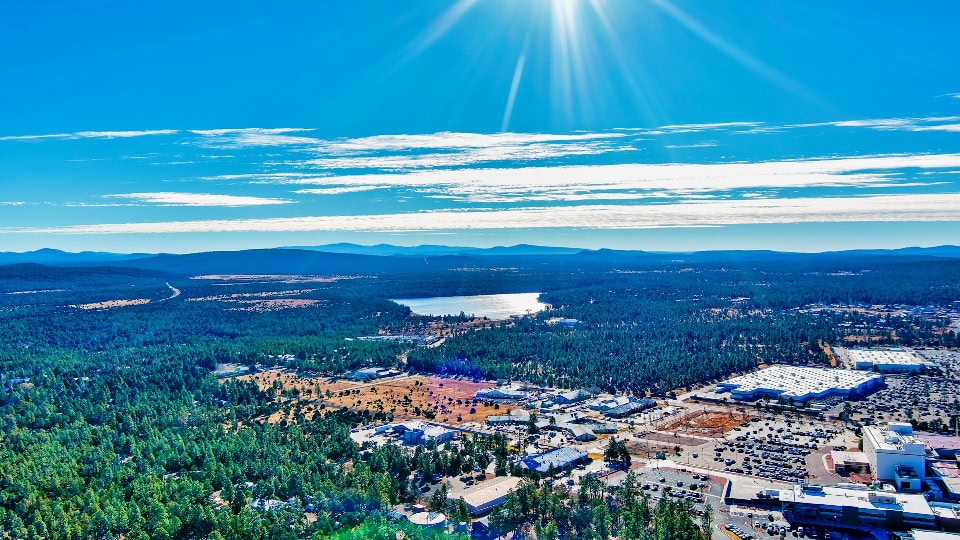
Show Low Lake
Show Low Lake was originally created in 1951 when Phelps Dodge, one of Arizona’s mining giants, purchased a parcel of land near Show Low. At the time, the company needed an additional source of water for its Morenci operation. A dam was built and the water impounded there soon became known as Show Low Lake.
Show Low had an agreement in place dating March of 1954 stating that upon Phelps Dodge abandonment of Show Low Lake, the water rights would transfer to the Show Low Irrigation Company and the City of Show Low. This event ultimately took place on June 29, 2005.
photo id: 432
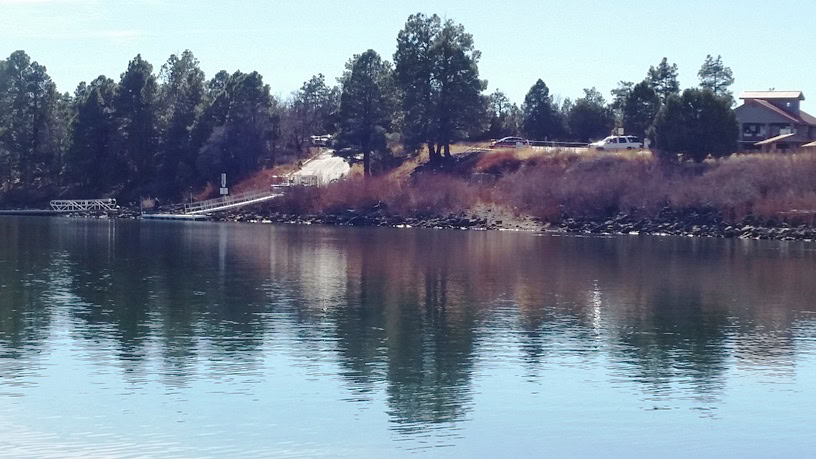
Show Low Lake
Show Low Lake has 100 surface acres with an average depth of 33 feet and maximum depth of 50 feet. It’s situated at an elevation of 6,500 feet.
photo id: 433
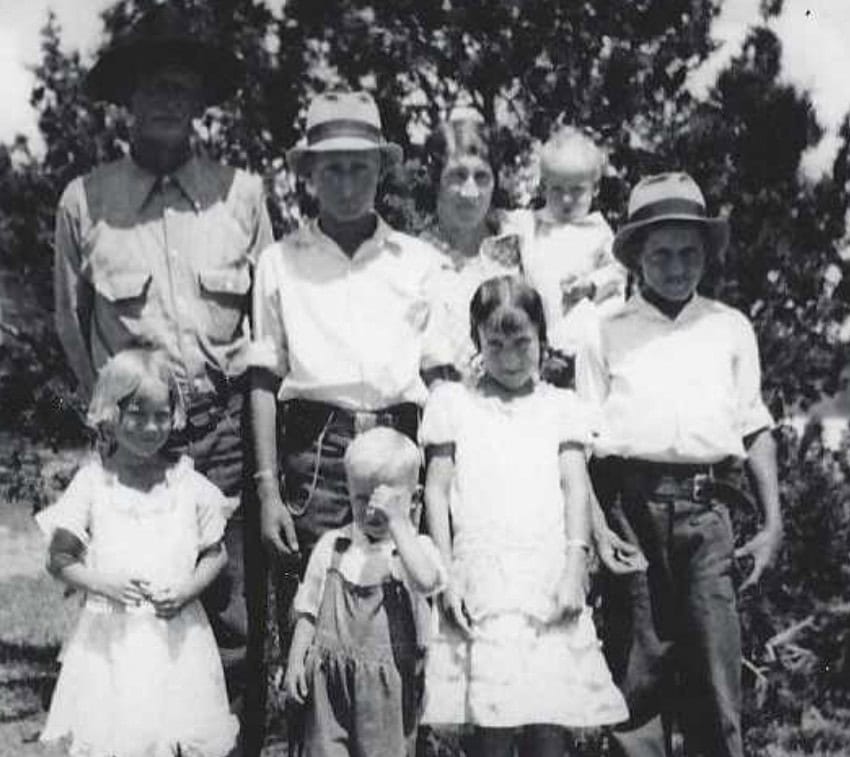
The Adams Family
Pictured here are the children of Edward Frank Adams and his wife Mettie Christina Adams.
Chester Frank Adams was born August 2,1923. He joined his father’s family of 6 children: May, Jane, Alice, Gladys, John, and Rose. His parents had 7 more children: Leonard, Chester, Mettie, Georgia, Glen, Harvey,and Shirley.
photo id: 435
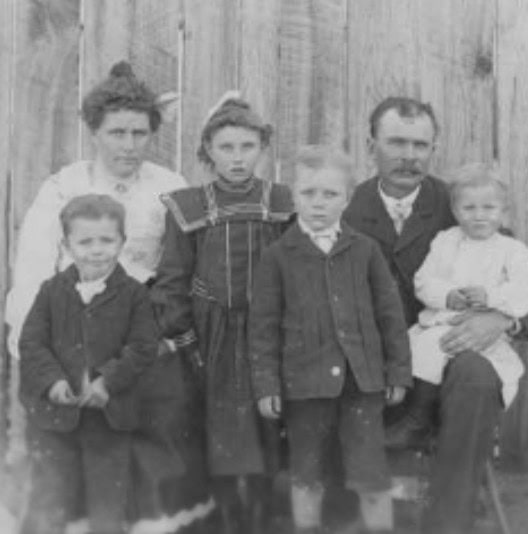
Adair or Adairville
Adair, or Adairville, was a Mormon settlement established in 1878 in what was then Apache County of Arizona Territory. It was located three miles northwest of Show Low. This area became Navajo County on March 21, 1895. Arizona officially became a state on February 14, 1912.
Pictured here are members of the Adair family, who were founding members of the town named after them.
photo id: 437
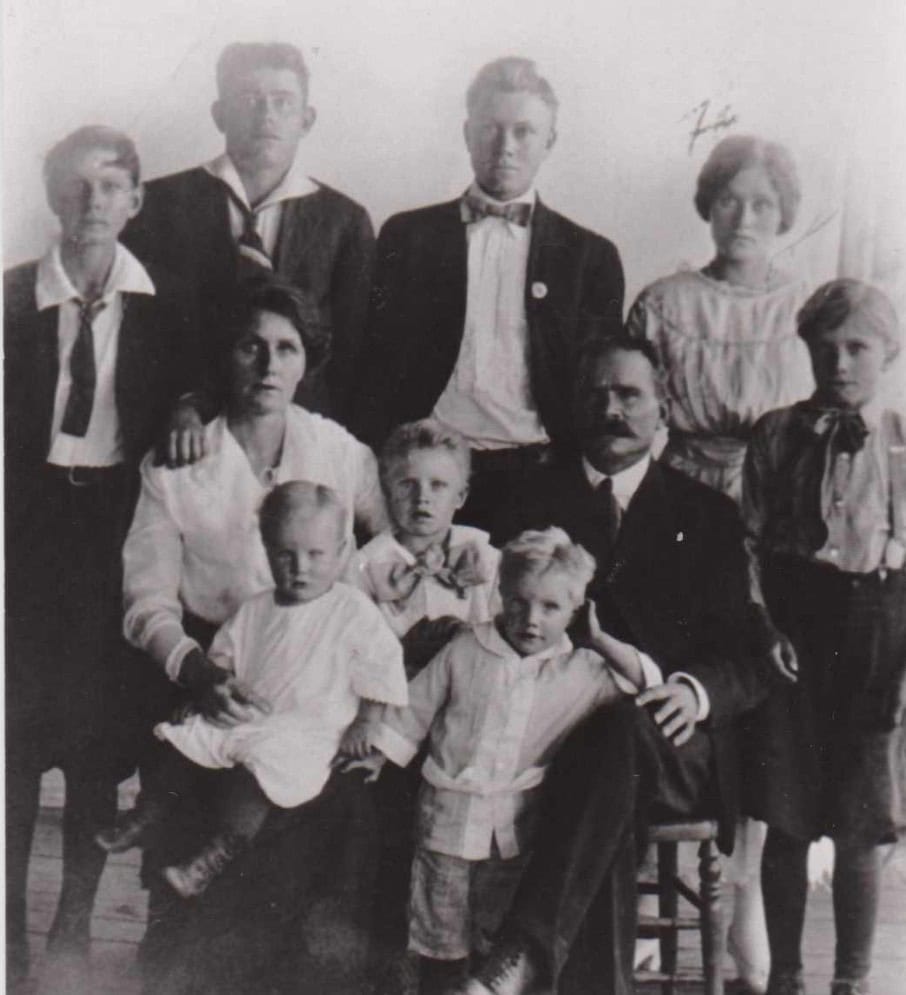
The Adair Family
The Adair family built a home about a quarter of a mile from Show Low Creek. Soon other families came and settled on the hills and in the valleys. It was beautiful country but had a limited supply of water. The settlers cleared the grounds and grew corn and sugar cane taller than a man. They also grew wheat, beans, and other vegetables.
Many of the Adairs and other families left the area and moved to Show Low and surrounding regions. Aaron Adair remained in the area for some years and was told “nobody but a fool would try to make a living there.” The settlement was renamed “Fool Hollow”, and is now the location of Fool Hollow Lake.
photo id: 438
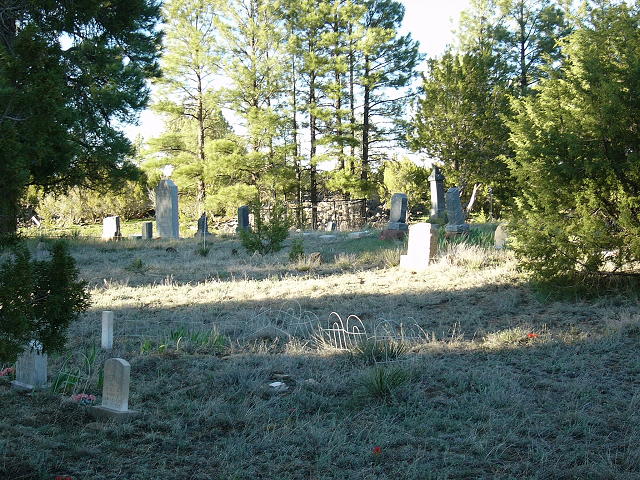
Adair Cemetery
Today all traces of the town of Adair are gone, except for this cemetery. The cemetery is located in Show Low, about one mile east of Fools Hollow Lake, at the end of 22nd Avenue and Old Linden Road. It is now private property and you must have permission to visit.
Etta Colvin, who died of Small Pox, was the first person to be buried at Adair Cemetery in February 1883. The cemetery was fenced by the Show Low Ward on March 13, 1923. John Lorenzo Willis was Bishop and leader of this project.
Today you can find a glass case with an alphabetical list of the names ,birth dates, and death dates of those buried there. This is thanks to the many descendants of the deceased.
photo id: 439
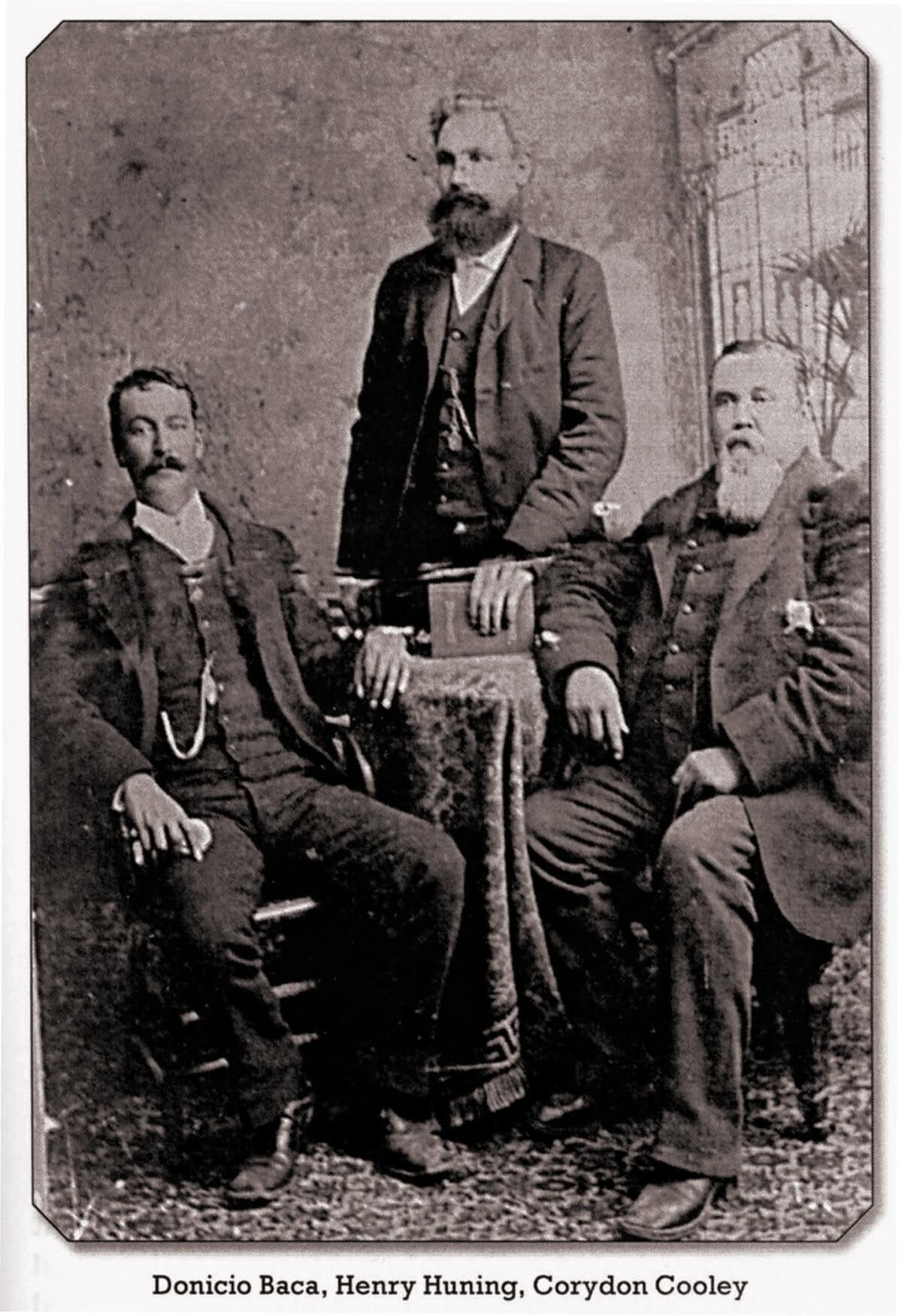
Baca, Huning & Cooley
Pictured here are Donico Baca, Henry Huning, and Corydon Cooley.
After Henry Huning purchased Corydon Cooley’s Ranch in 1888, he attempted to extend his empire by fencing North and East of the Show Low Valley. In 1901 the railroad contested his rights.
Legend has it that Cooley was married to two of Apache Chief Pedro’s daughters at one time.
photo id: 174
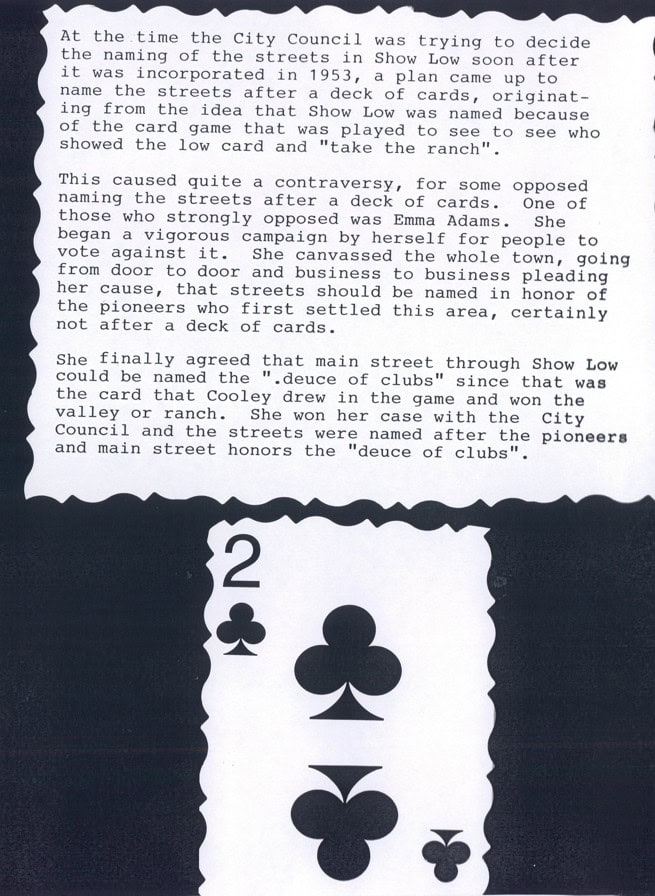
Naming Show Low
The settlement of Show Low was too small for its first two residents, Corydon Cooley and Marion Clark.
Legend says they played a card game to determine which of them would stay. The loser had to leave town and settle elsewhere. Towards the end of the game Cooley needed just one point to win. Clark turned his cards over and said,”If you can show low you win.” Cooley threw down his hand of cards and said “show low it is.’ And thus the name Show Low was born.
The Post Office of Show Low was established August 19, 1880.
photo id: 182
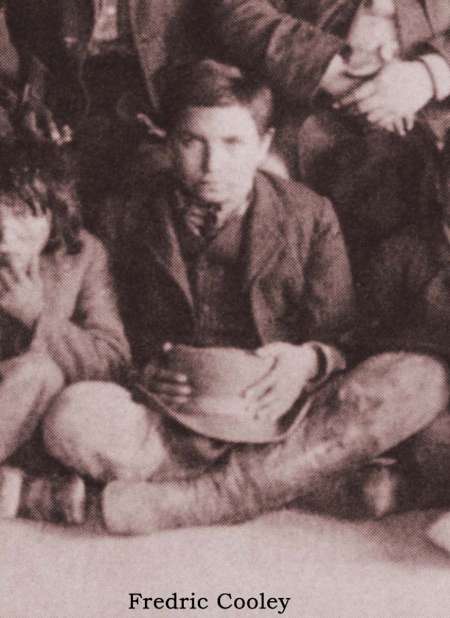
First Son Fredric
Pictured here is one of the sons of Corydon E. Cooley of Fort Apache. Corydon “C.E.” Cooley sent his sons, Fredric and Charlie, to a boarding school in New Mexico. Cooley transported the boys as well as many other White Mountain Apache children to the boarding school himself.
A few weeks later Fredric contracted measles, which turned into pneumonia. He died before the family could be notified of his illness.
Lillie, Fredric’s sister, said that their mother, Mollie, took Fredric’s death really hard. For a long time she would go to where Fredric used to hang his coat at home and run her hands over it and cry. Lillie said that Mollie mourned him for a long time.
photo id: 183
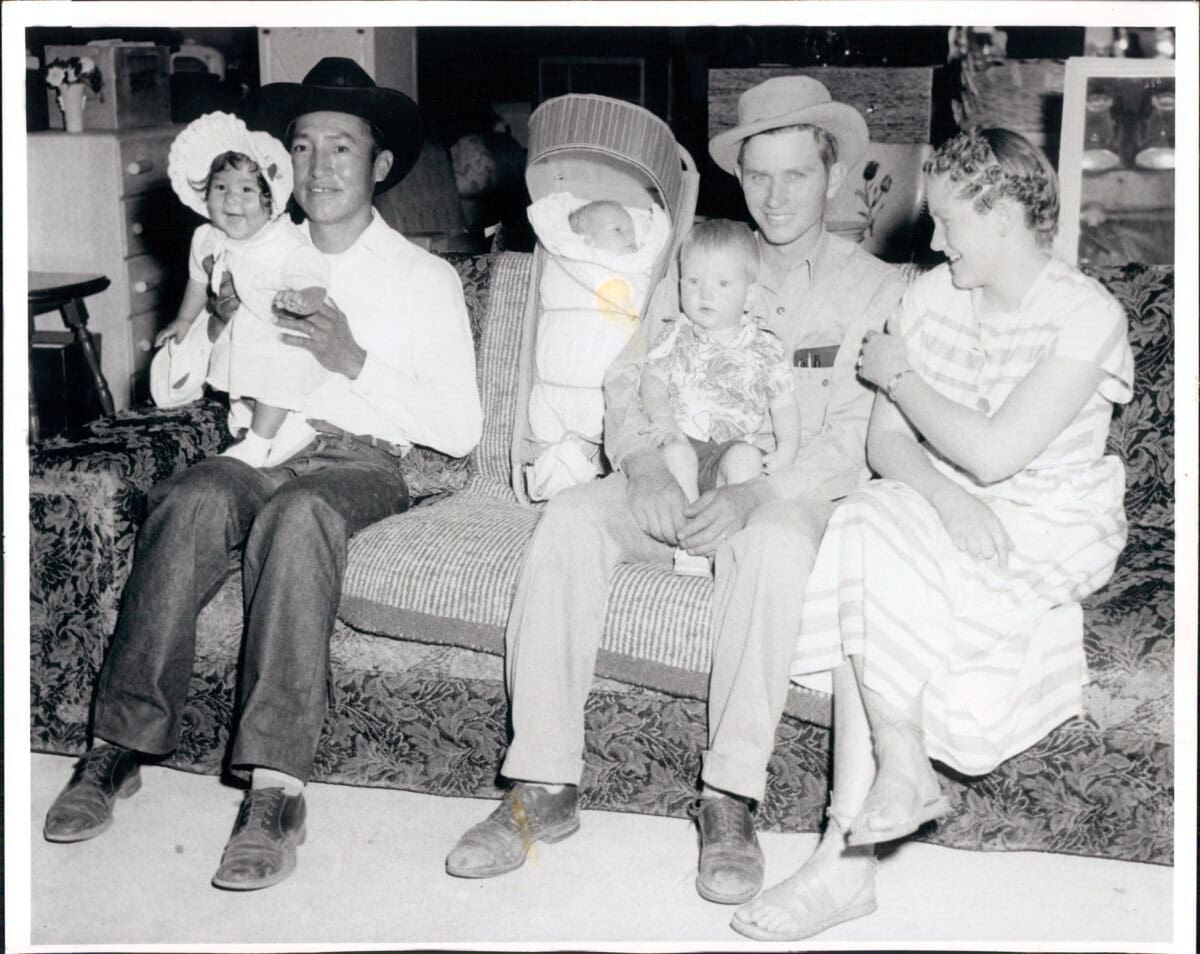
Eb Lewis With Friends
Elbert “Eb” Lewis owned a secondhand store, and was known for his outlandish floats in the annual 4th of July parades. He enjoyed figuring out how to make a Maytag or bathtub run down the street. The people of Show low enjoyed watching for his latest float designs.
The parade of 1992 was a hard one for Eb. He wanted to be in it was feeling poorly. He had participated in Show Low parades for many years. He stayed home that year, and passsed away the following September. He was 60 years old.
photo id: 185
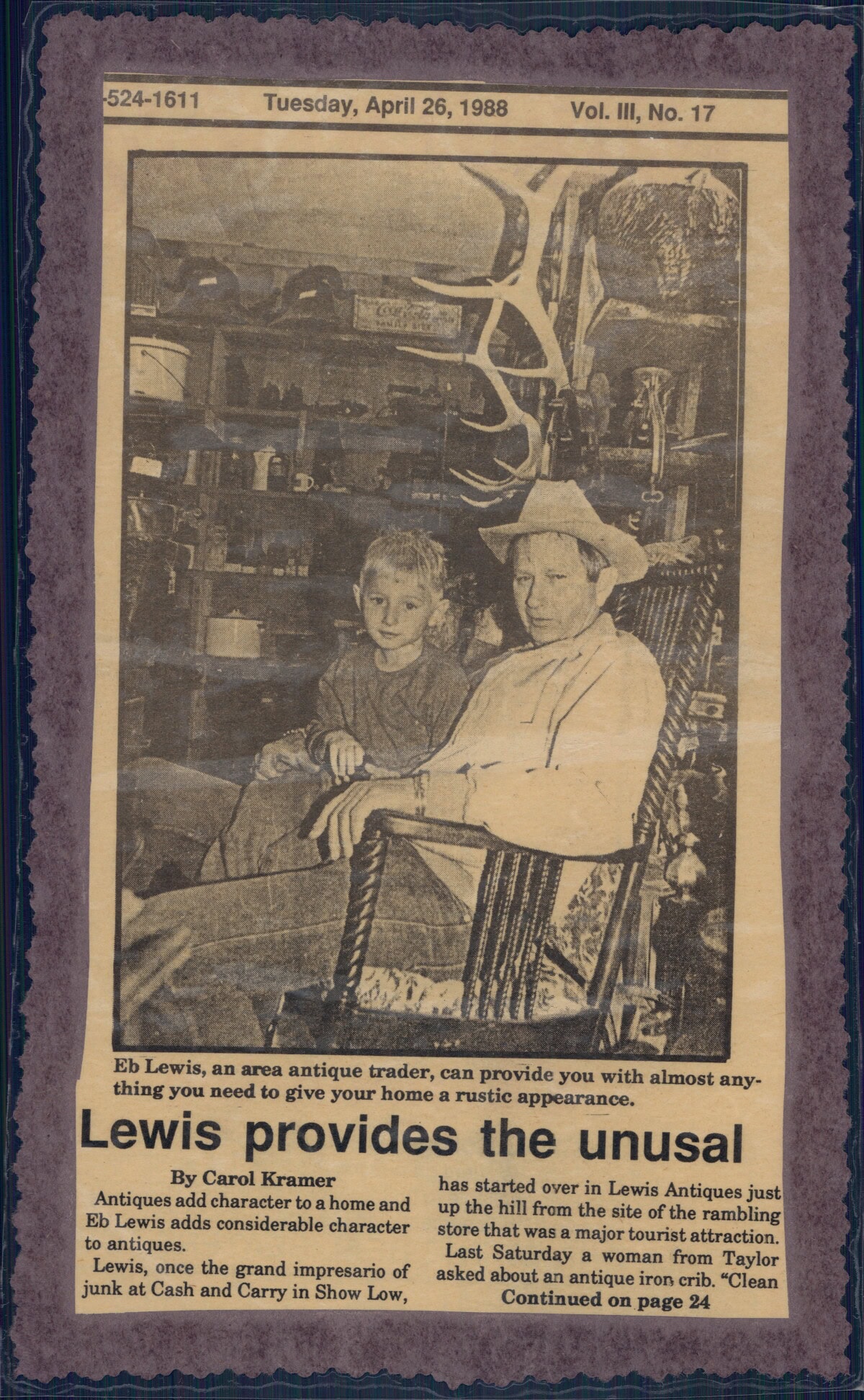
You Want It – I Got It!
Eb Lewis was one of Show Low’s best known and respected citizens. He owned and operated the Cash n’ Carry antique store for almost 30 years.
If you asked Eb for something he would go right to his piles of treasure and pull it out. Residents have remarked that if Eb Lewis didn’t have it, he would always get it for you!
photo id: 186
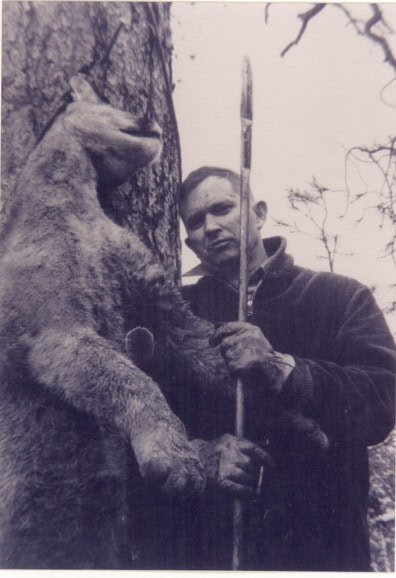
The Lion Slayed with a Spear
This is an actual lion slain by Eb Lewis with his spear.
Eb had many hobbies throughout the years. He was a great hunter in his younger days. He also enjoyed scuba diving, flying, rock collecting and cutting, silver-smiting, painting, wood-turning, Dutch oven cooking and stained glass.
photo id: 187
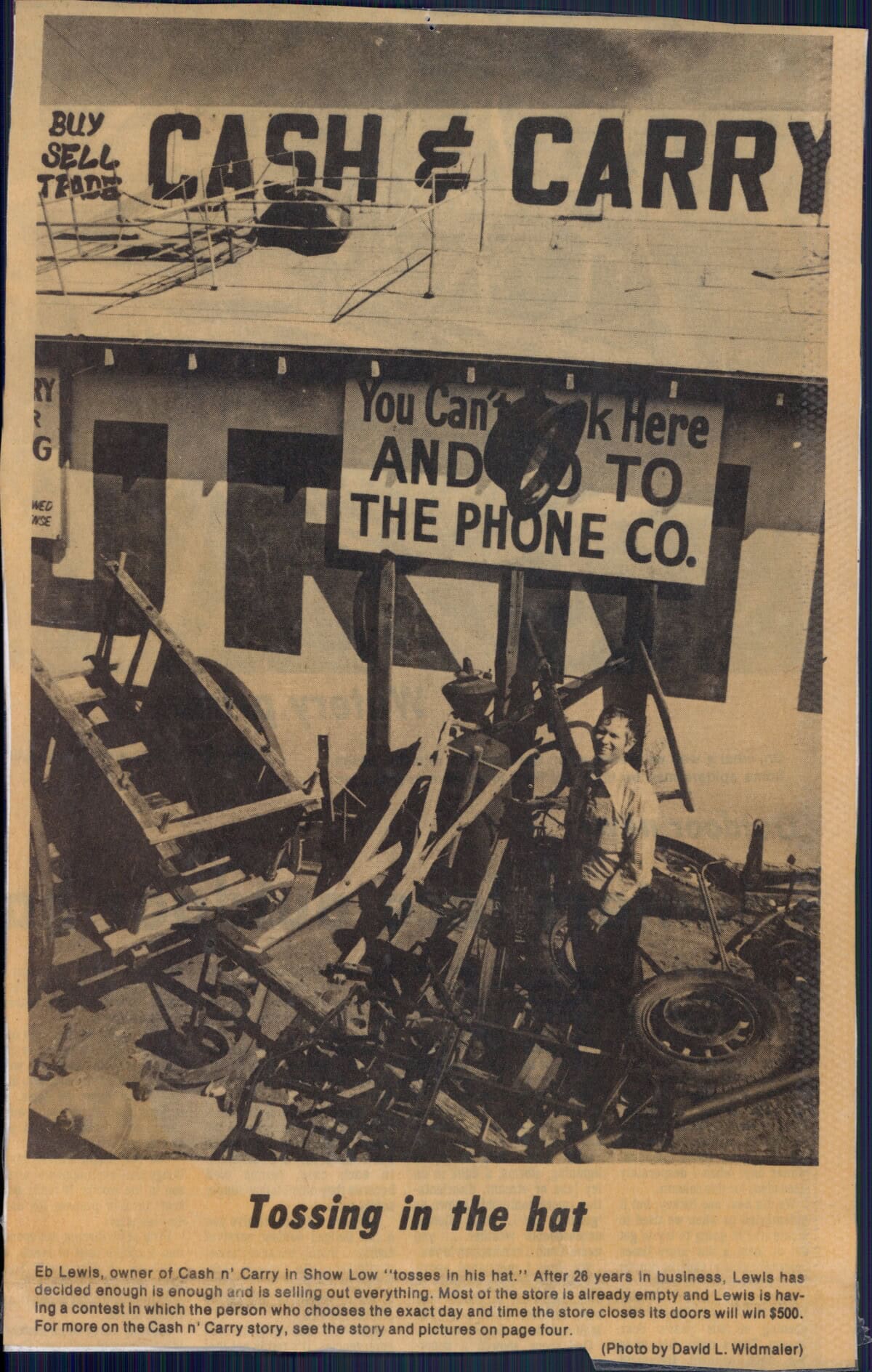
Eb Lewis in the Cash and Carry
Here is another article regarding Eb Lewis and his store the Cash & Carry. You can tell by looking at the photo that his store was overflowing with merchandise.
One of things Eb was most famous for was his soapbox car made from a Maytag washing machine. Imagine seeing him ride down the Deuce Of Clubs (the main street in Show Low) stopping every so often to pop his head out of the machine to say hello!
photo id: 188
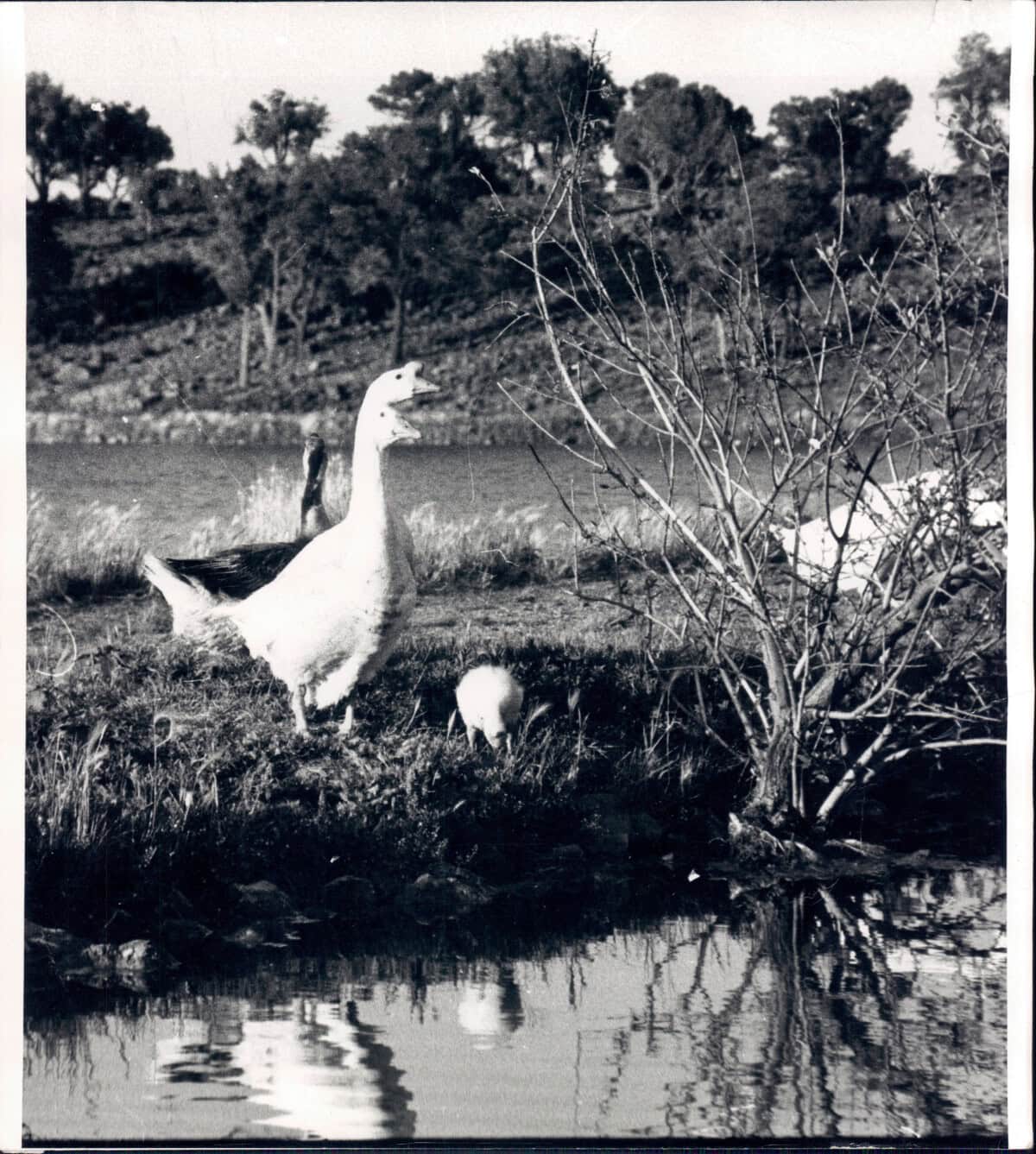
Two-Headed Goose
This photo of the “Two Headed Goose” was one Eb Lewis’ favorites, and illustrates his creativity and sense of humor. He waited until two geese were standing just right and snapped the picture, making it appear that the front goose had two heads.
photo id: 191

Deuce Of Clubs
This Show Low road is called The Deuce Of Clubs. The intersection you see is the corner of White Mountain Boulevard. Today the Shell gas station is the Branding Iron restaurant.
The 1940’s and 1950’s brought about major developments in Show Low. Many local business opened. A post office was opened on Old Linden, which was the old Tanner’s Variety.
The town was very popular for many commercial truck lines. This was prior to Interstate 40 opening. Truck drivers enjoyed the comfort of having homecooked meals in a family environment with people who recognized and knew them by name. You can still feel that small town appeal when visiting the town today.
photo id: 194
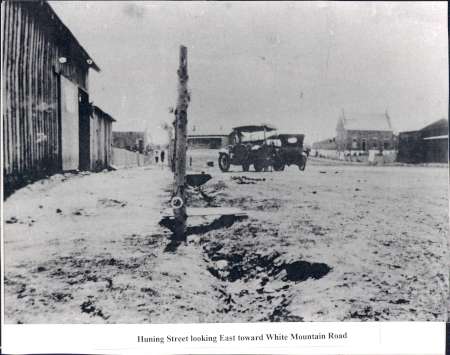
Show Low’s Snow
This picture was taken on Huning Street looking to the east towards White Mountain Boulevard. It was taken in the mid or late 1930s.
photo id: 197
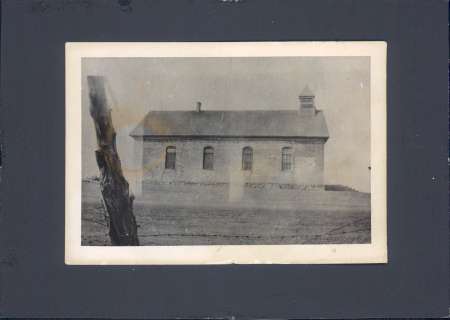
The Old Church
The old church in Show Low was originally planned as a school. It was used for many activities, even the wedding dance of Katie Pearl Adams & Roy Penrod on July 21,1911.It was later torn down and the building materials were used for other buildings.
Today there is a new church on the site. It was dedicated in 1953 and is known as the Downtown Chapel.
photo id: 202
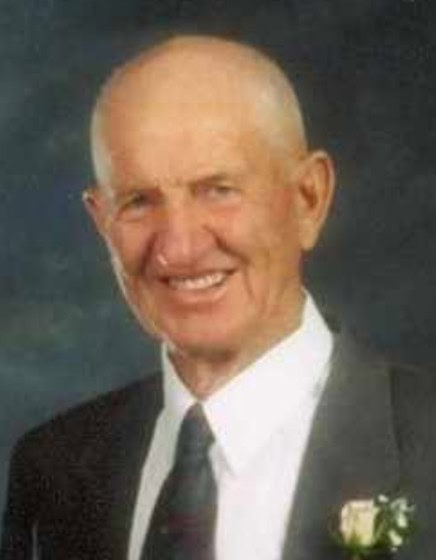
Chester Frank Adams
Chester “Chet” Frank Adams, born in 1923, grew up on the east side of Show Low Creek. When he was 10 he moved to where Show Low Lake is now. When Chet was old enough for high school, he rode the bus to Snowflake Union High School. It was here that he met his future wife, Clea Pearce. They were married in 1943
Chet built a home for them in Show Low, and this was where they had their four children. Charlotte who was born in 1946, Beverly in 1948, Chester Trent in 1953, and Farrell Edward in 1957. They also raised a foster child, a Navajo boy named Norman Bryant, for eight years. All of Chet’s children graduated from Brigham Young University. Chet was a farmer, but also served in church and community organizations. Chet passed away in 2010.
photo id: 424

Cooley’s Hired Hands
Corydon Eliphalet Cooley was born in 1836 in Virgina and at the age of 20 came out West to find gold and adventure. It is said that he failed to find gold; but, he certainly had plenty of tales of his journey and his wild adventures. During the Civil War he joined the Union Army and fought Confederate forces in New Mexico.
Cooley and his family established a ranch near what would later become Show Low. Pictured here are some of his hired help. From left to right are Roy Amos, Charley Cooley, McBride, Charley Faught, Charlie Pettis and Diddy Pettis.
photo id: 100
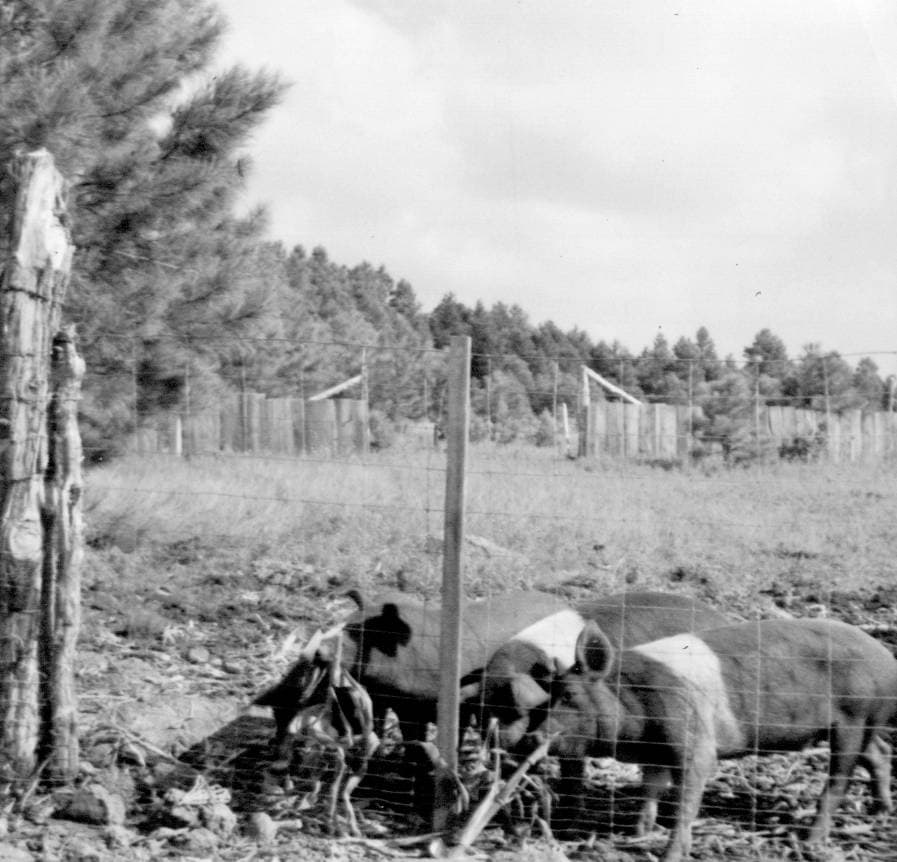
Grazing Cattle
Cattle grazing on a summer range (USFS Photo) in 1937. Monsoon rains bring lush growth of grass for grazing in the many broad meadows in the White Mountains.
Today, cattle still graze in these mountains. They often share their range with hundreds of elk.
photo id: 671

Dr. Dysterheft’s Cattle
Dr. Dysterheft had many Herefords which were given to him by a friend. You could see him moving his cattle from one pasture to another so they could graze. One of these pastures, located across the highway where the Maverick Center is now, was called Dr. D’s Meadow.
Whenever there was a snowstorm or heavy rain, before Highway 260 was built, people would use the meadow as a landmark.
photo id: 387

